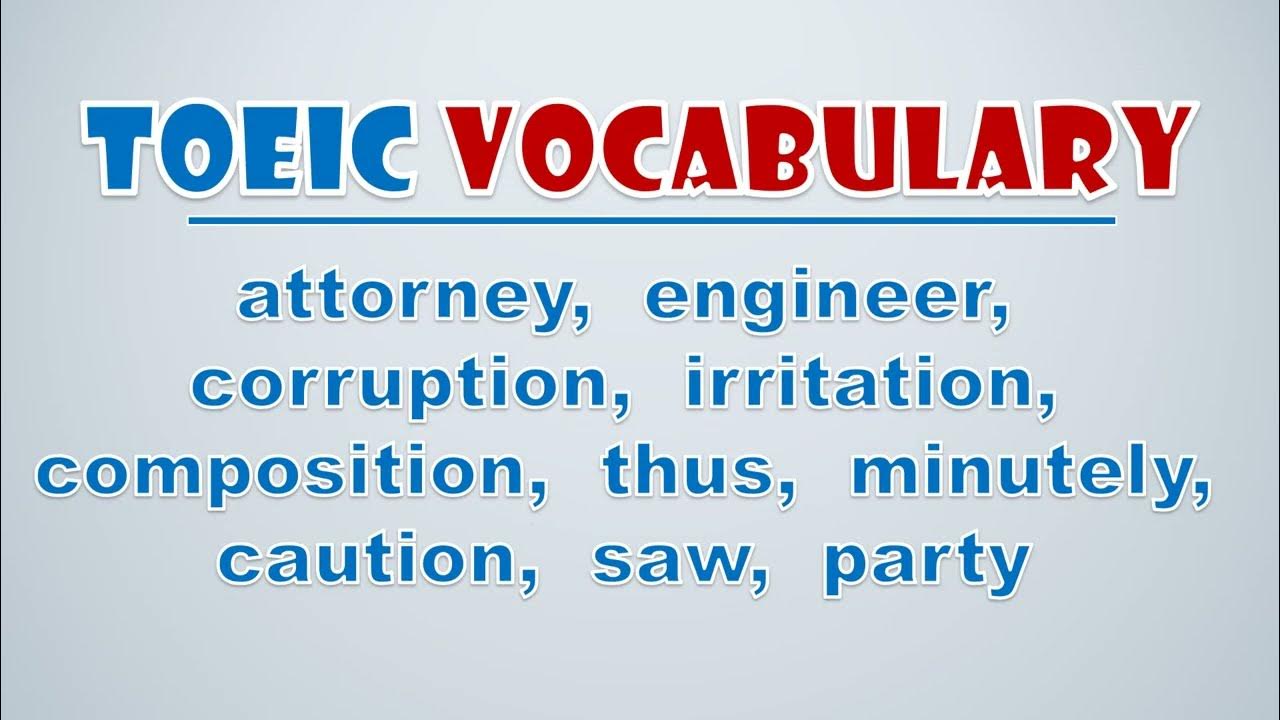
TOEIC Vocabulary: attorney, engineer, corruption, irritat...
80 views · Apr 14, 2023 englishteststore.net
TOEIC Vocabulary: attorney, engineer, corruption, irritation, composition, thus, minutely, caution, saw, part - Thank you for watching! Please subscribe, share, and like the video. EnglishTestStore ►https://englishteststore.net/ Facebook ►https://www.facebook.com/englishteststore.net/ Twitter ►https://twitter.com/englishteststor
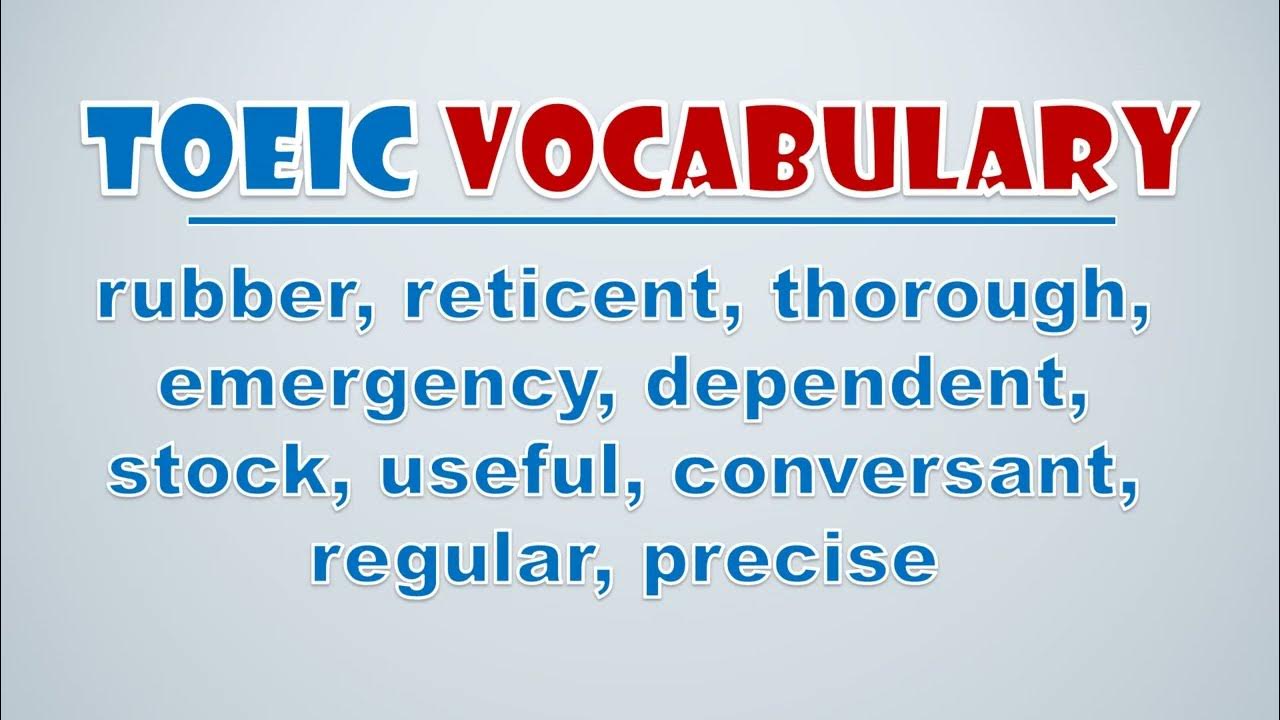
TOEIC Vocabulary: rubber, reticent, thorough, emergency, dep...
825 views · Apr 14, 2023 englishteststore.net
TOEIC Vocabulary: rubber, reticent, thorough, emergency, dependent, stock, useful, conversant, regular, precise - Thank you for watching! Please subscribe, share, and like the video. EnglishTestStore ►https://englishteststore.net/ Facebook ►https://www.facebook.com/englishteststore.net/ Twitter ►https://twitter.com/englishteststor
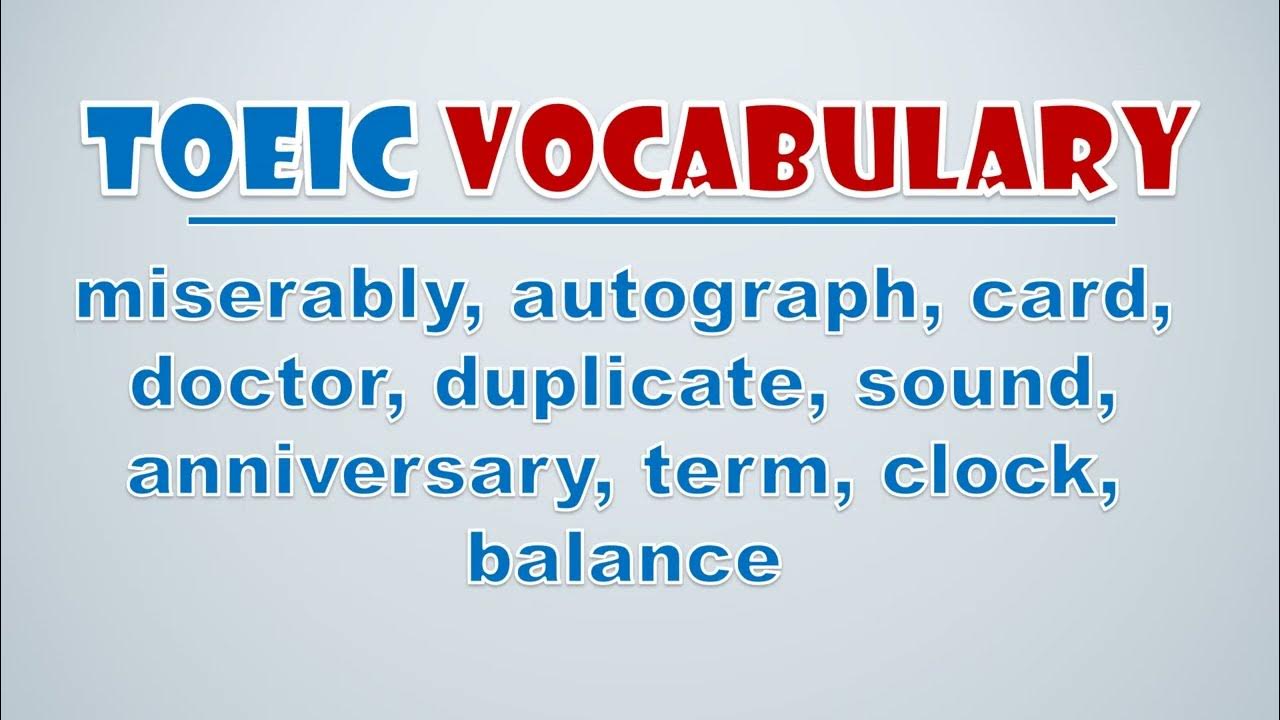
TOEIC Vocabulary: miserably, autograph, card, doctor, duplic...
6K views · Apr 11, 2023 englishteststore.net
TOEIC Vocabulary: miserably, autograph, card, doctor, duplicate, sound, anniversary, term, clock - Thank you for watching! Please subscribe, share, and like the video. EnglishTestStore ►https://englishteststore.net/ Facebook ►https://www.facebook.com/englishteststore.net/ Twitter ►https://twitter.com/englishteststor
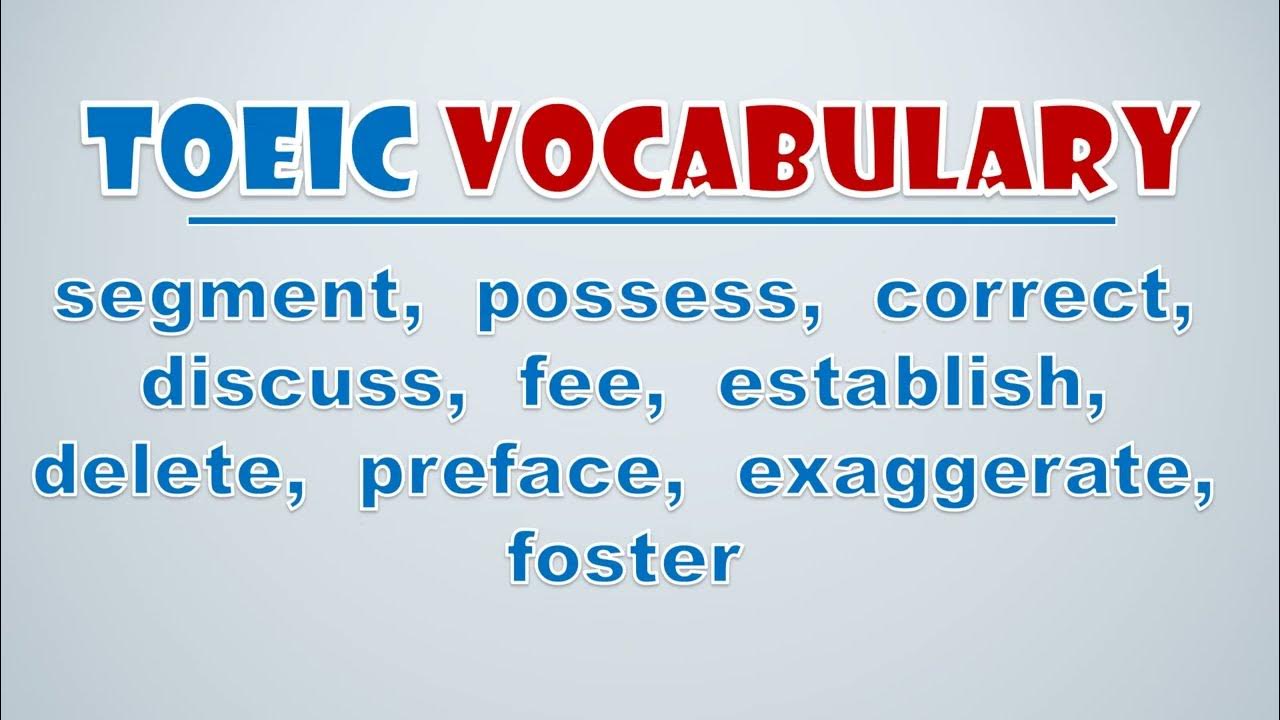
TOEIC Vocabulary: segment, possess, correct, discuss, fe...
2K views · Apr 15, 2023 englishteststore.net
TOEIC Vocabulary: segment, possess, correct, discuss, fee, establish, delete, preface, exaggerate, foster - Thank you for watching! Please subscribe, share, and like the video. EnglishTestStore ►https://englishteststore.net/ Facebook ►https://www.facebook.com/englishteststore.net/ Twitter ►https://twitter.com/englishteststor
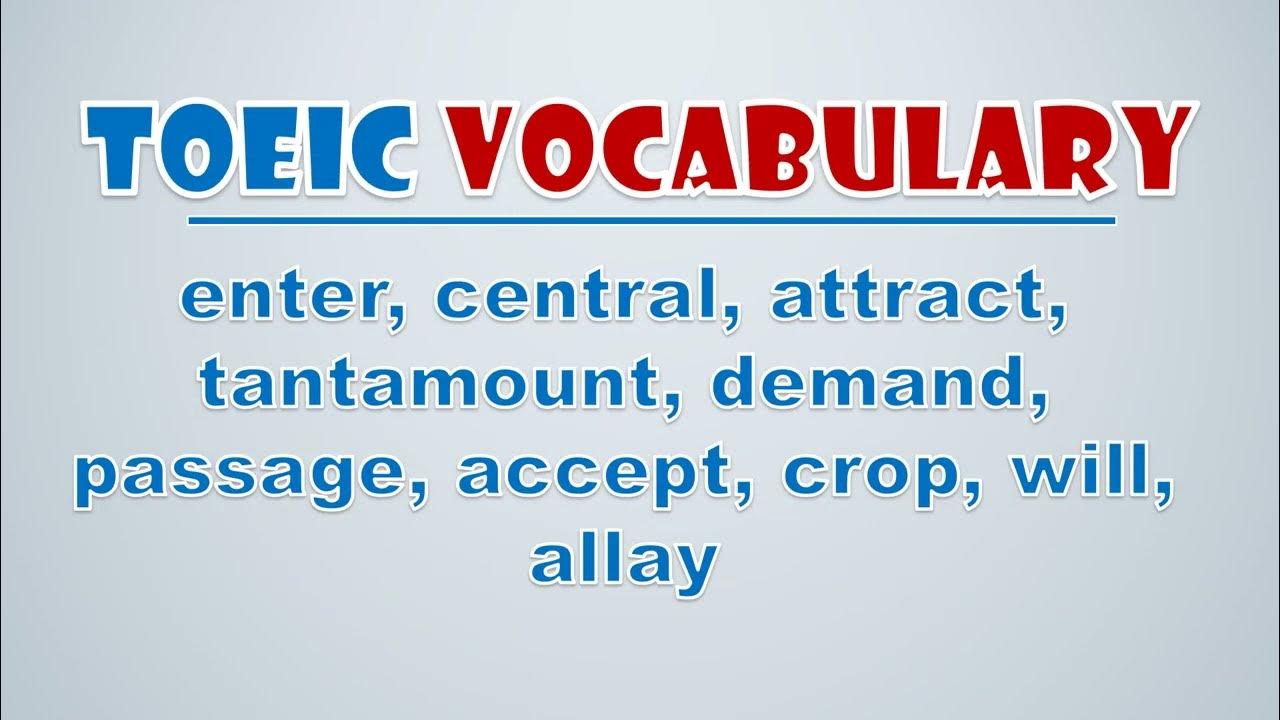
TOEIC Vocabulary: Enter, Central, Attract, Tantamount, Dema...
86 views · May 11, 2023 englishteststore.net
Practice TOEIC online at https://englishteststore.net/index.php?option=com_content&view=article&id=11506&Itemid=227 - Thank you for watching! Please subscribe, share, and like the video. #toeic #toeicvocabulary #toeictest #toeiclistening #toeicreading #toeicwriting #toeic990 EnglishTestStore ►https://englishteststore.net/ Facebook ►https://www.facebook.com/englishteststore.net/ Twitter ►https://twitter.com/englishteststor
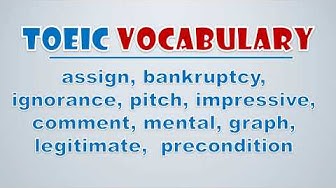
TOEIC Vocabulary: Assign, Bankruptcy, Ignorance, Pitch, Imp...
14 views · May 4, 2023 englishteststore.net
Practice TOEIC online at https://englishteststore.net/index.php?option=com_content&view=article&id=11506&Itemid=227 - Thank you for watching! Please subscribe, share, and like the video. #toeic #toeicvocabulary #toeictest #toeiclistening #toeicreading #toeicwriting #toeic990 EnglishTestStore ►https://englishteststore.net/ Facebook ►https://www.facebook.com/englishteststore.net/ Twitter ►https://twitter.com/englishteststor
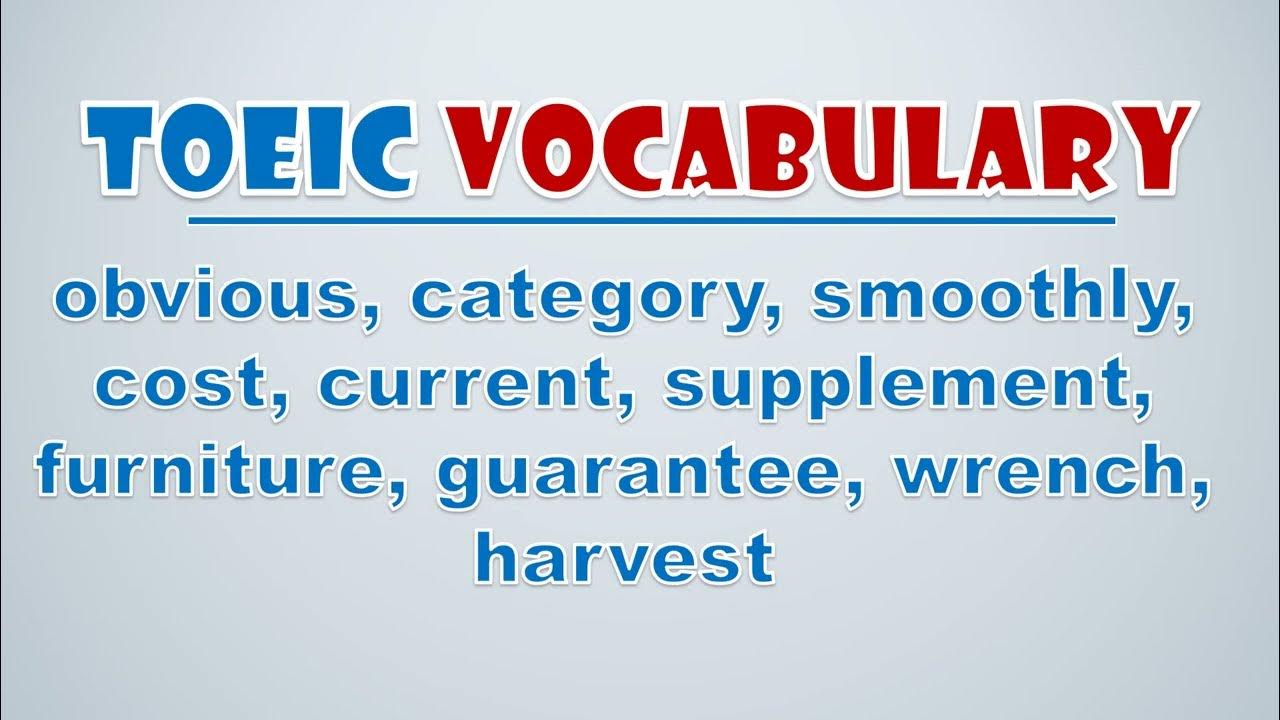
TOEIC Vocabulary: obvious, category, smoothly, cost, current...
106 views · Apr 18, 2023 englishteststore.net
TOEIC Vocabulary: obvious, category, smoothly, cost, current, supplement, furniture, guarantee - Thank you for watching! Please subscribe, share, and like the video. EnglishTestStore ►https://englishteststore.net/ Facebook ►https://www.facebook.com/englishteststore.net/ Twitter ►https://twitter.com/englishteststor
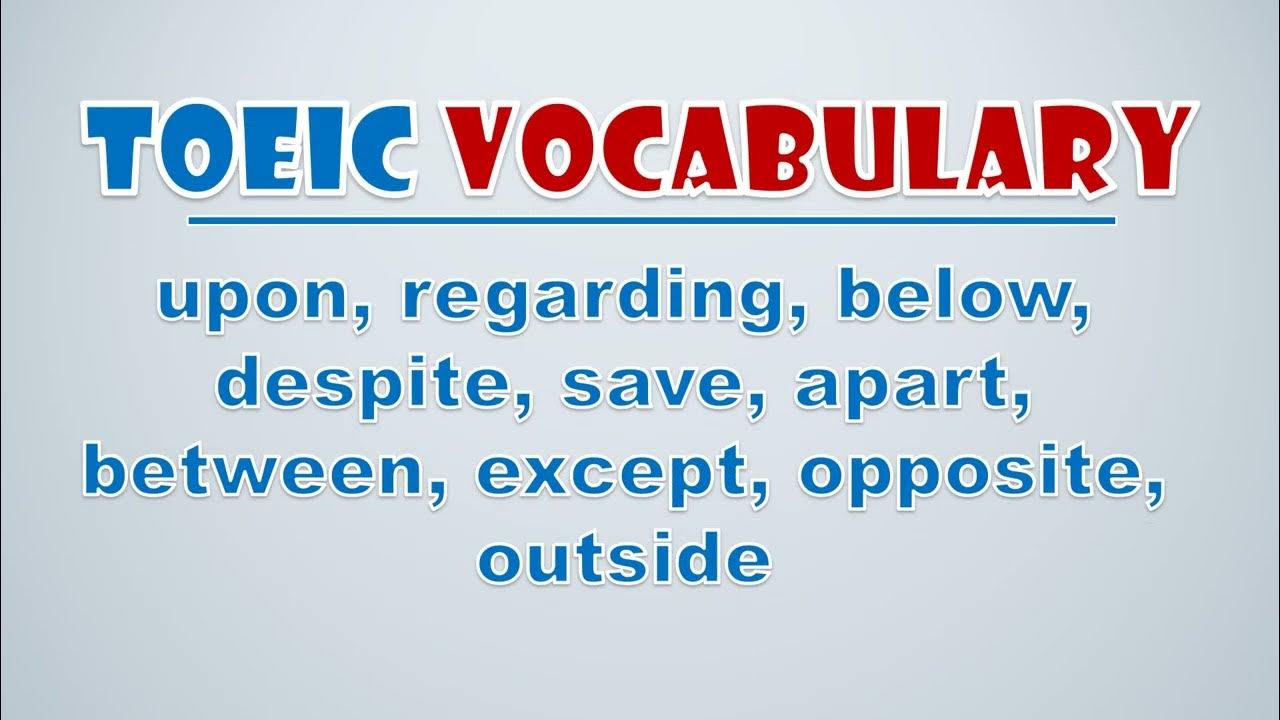
TOEIC Vocabulary: upon, regarding, below, despite, save, apa...
988 views · Apr 16, 2023 englishteststore.net
TOEIC Vocabulary: upon, regarding, below, despite, save, apart, between, except, opposite, outside - Thank you for watching! Please subscribe, share, and like the video. EnglishTestStore ►https://englishteststore.net/ Facebook ►https://www.facebook.com/englishteststore.net/ Twitter ►https://twitter.com/englishteststor
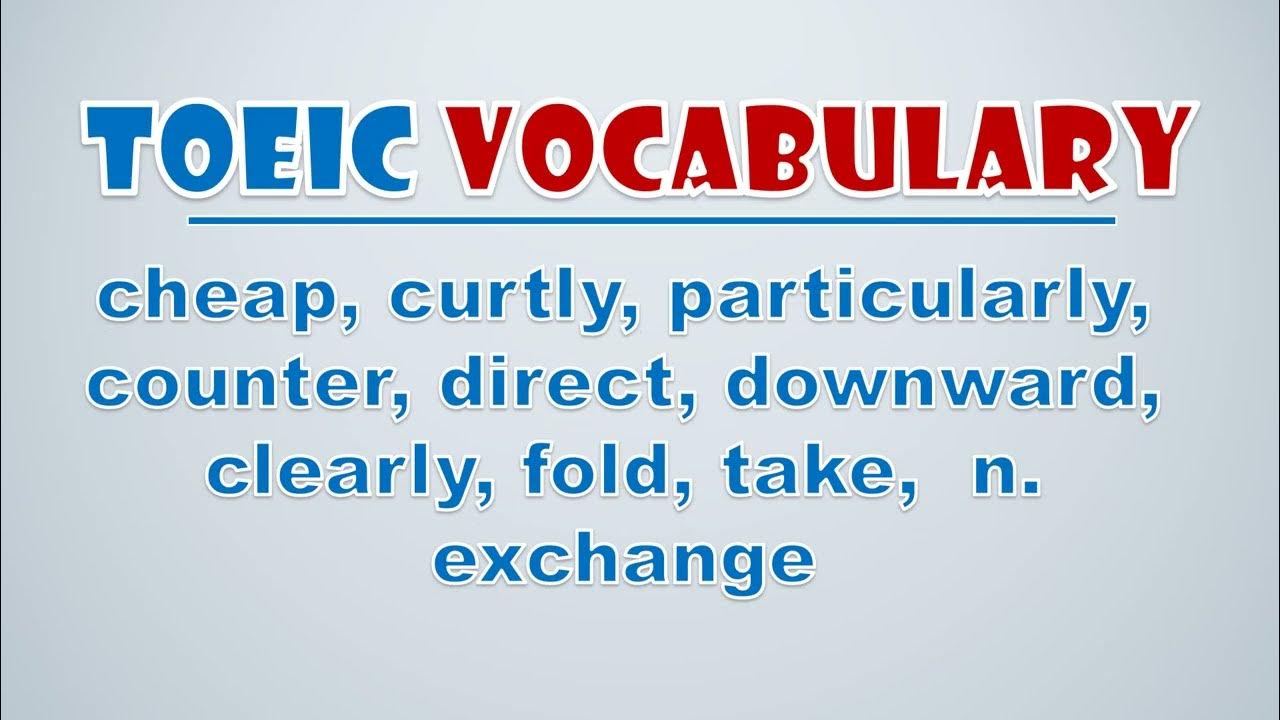
TOEIC Vocabulary: cheap, curtly, particularly, counter, dire...
423 views · Apr 16, 2023 englishteststore.net
TOEIC Vocabulary: cheap, curtly, particularly, counter, direct, downward, clearly, fold, take - Thank you for watching! Please subscribe, share, and like the video. EnglishTestStore ►https://englishteststore.net/ Facebook ►https://www.facebook.com/englishteststore.net/ Twitter ►https://twitter.com/englishteststor

TOEIC Vocabulary: segment, possess, correct, discuss, fe...
2K views · Apr 15, 2023 englishteststore.net
TOEIC Vocabulary: segment, possess, correct, discuss, fee, establish, delete, preface, exaggerate, foster - Thank you for watching! Please subscribe, share, and like the video. EnglishTestStore ►https://englishteststore.net/ Facebook ►https://www.facebook.com/englishteststore.net/ Twitter ►https://twitter.com/englishteststor

TOEIC Vocabulary: attorney, engineer, corruption, irritat...
80 views · Apr 14, 2023 englishteststore.net
TOEIC Vocabulary: attorney, engineer, corruption, irritation, composition, thus, minutely, caution, saw, part - Thank you for watching! Please subscribe, share, and like the video. EnglishTestStore ►https://englishteststore.net/ Facebook ►https://www.facebook.com/englishteststore.net/ Twitter ►https://twitter.com/englishteststor

TOEIC Vocabulary: rubber, reticent, thorough, emergency, dep...
825 views · Apr 14, 2023 englishteststore.net
TOEIC Vocabulary: rubber, reticent, thorough, emergency, dependent, stock, useful, conversant, regular, precise - Thank you for watching! Please subscribe, share, and like the video. EnglishTestStore ►https://englishteststore.net/ Facebook ►https://www.facebook.com/englishteststore.net/ Twitter ►https://twitter.com/englishteststor

TOEIC Vocabulary: miserably, autograph, card, doctor, duplic...
6K views · Apr 11, 2023 englishteststore.net
TOEIC Vocabulary: miserably, autograph, card, doctor, duplicate, sound, anniversary, term, clock - Thank you for watching! Please subscribe, share, and like the video. EnglishTestStore ►https://englishteststore.net/ Facebook ►https://www.facebook.com/englishteststore.net/ Twitter ►https://twitter.com/englishteststor
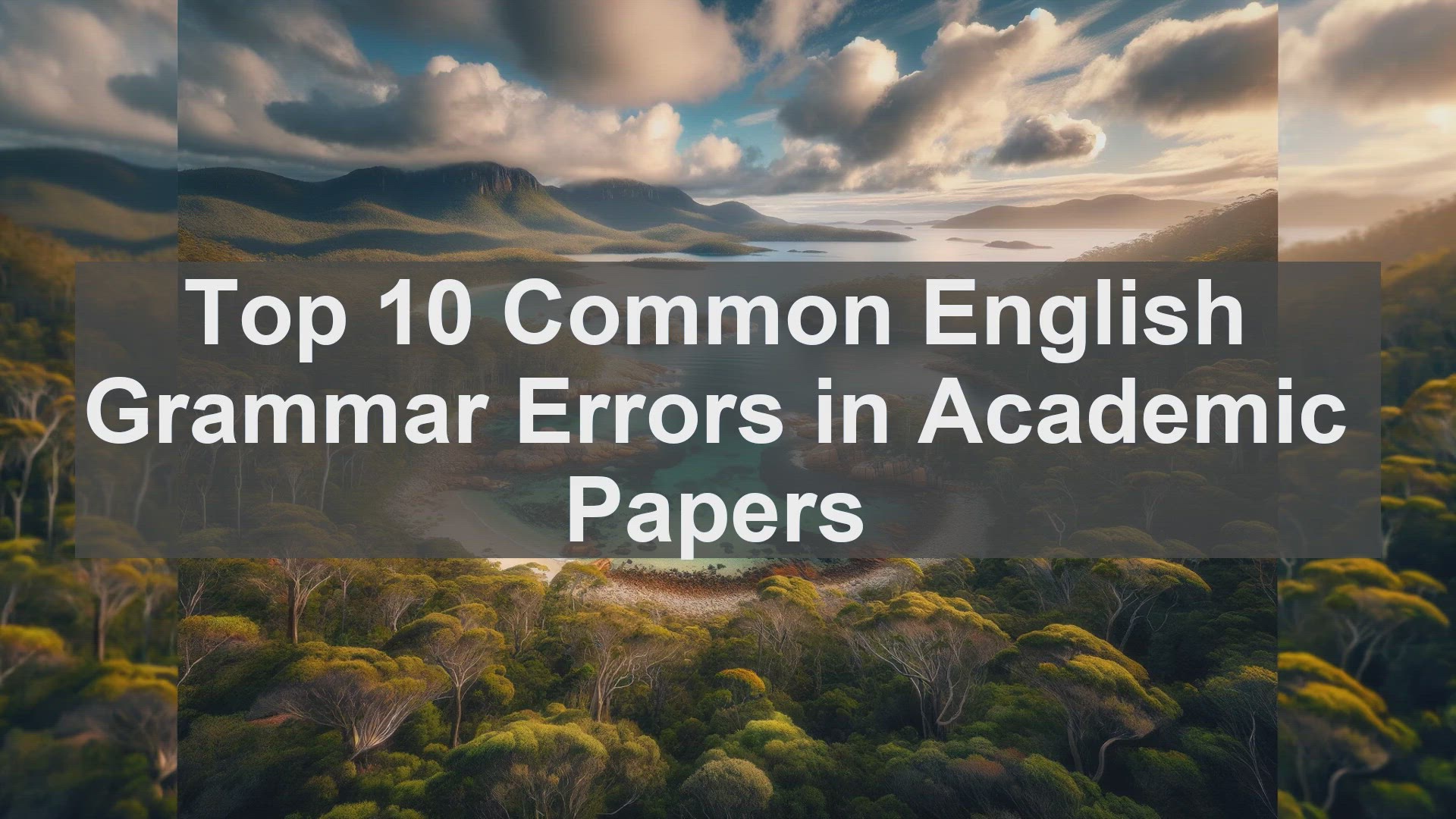
Top 10 Common English Grammar Errors in Academic Papers
7K views · Nov 14, 2023 englishteststore.net
Top 10 Common English Grammar Errors in Academic Papers Introduction Hello everyone! Welcome to today's video. As students, we often come across various grammar errors in our academic papers. These errors can negatively impact our grades and overall impression. So, in this video, we'll be discussing the top 10 common English grammar errors found in academic papers. Let's dive in! 1. Subject-Verb Agreement One of the most common errors is the mismatch between the subject and the verb. For example, saying 'The data is' instead of 'The data are.' Remember, singular subjects need singular verbs, and plural subjects need plural verbs. 2. Misplaced Modifiers Modifiers, such as adjectives or adverbs, should be placed near the words they modify. A common mistake is placing the modifier too far from the word, leading to confusion. For instance, 'The professor only taught one chapter' instead of 'The professor taught only one chapter.' 3. Run-on Sentences Run-on sentences occur when two or more independent clauses are joined without proper punctuation. These sentences can be confusing to read. To fix this, use appropriate punctuation or consider breaking the sentence into smaller ones. 4. Lack of Parallelism Parallelism refers to using the same grammatical structure for similar ideas. For example, 'She likes hiking, swimming, and to run' should be 'She likes hiking, swimming, and running.' Maintaining parallelism improves the flow and clarity of your writing. 5. Incorrect Pronoun Usage Using pronouns incorrectly can lead to confusion. For instance, 'Everyone should bring their own book' should be 'Everyone should bring his or her own book.' If the gender is unknown, use 'his or her' or rephrase the sentence to avoid pronoun issues. 6. Improper Use of Apostrophes Apostrophes are commonly misused. Remember, they indicate possession or contraction. For example, 'The students' notebooks' indicates possession, while 'It's a beautiful day' is a contraction of 'It is.' Be cautious not to confuse the two. 7. Lack of Consistency in Verb Tenses Maintaining consistency in verb tenses is crucial. Shifting between past, present, and future tenses without a clear reason can confuse the reader. Choose the appropriate tense and stick to it throughout your paper. 8. Incorrect Capitalization Capitalization errors can make your writing appear unprofessional. Remember to capitalize proper nouns, the first word of a sentence, and titles. For example, 'I visited the White house' should be 'I visited the White House.' 9. Lack of Comma Usage Commas are essential for clarity and proper sentence structure. A common mistake is the absence of a comma in compound sentences. For instance, 'I went to the store and bought milk bread and eggs' should be 'I went to the store and bought milk, bread, and eggs.' 10. Wordiness Lastly, wordiness can make your writing convoluted. Be concise and to the point. Avoid unnecessary repetition or using complex words when simpler ones suffice. Remember, clarity is key. Conclusion And there you have it, the top 10 common English grammar errors found in academic papers. By being aware of these errors and actively working to avoid them, you can significantly improve your writing. Remember, practice makes perfect. Thanks for watching, and see you in the next video!
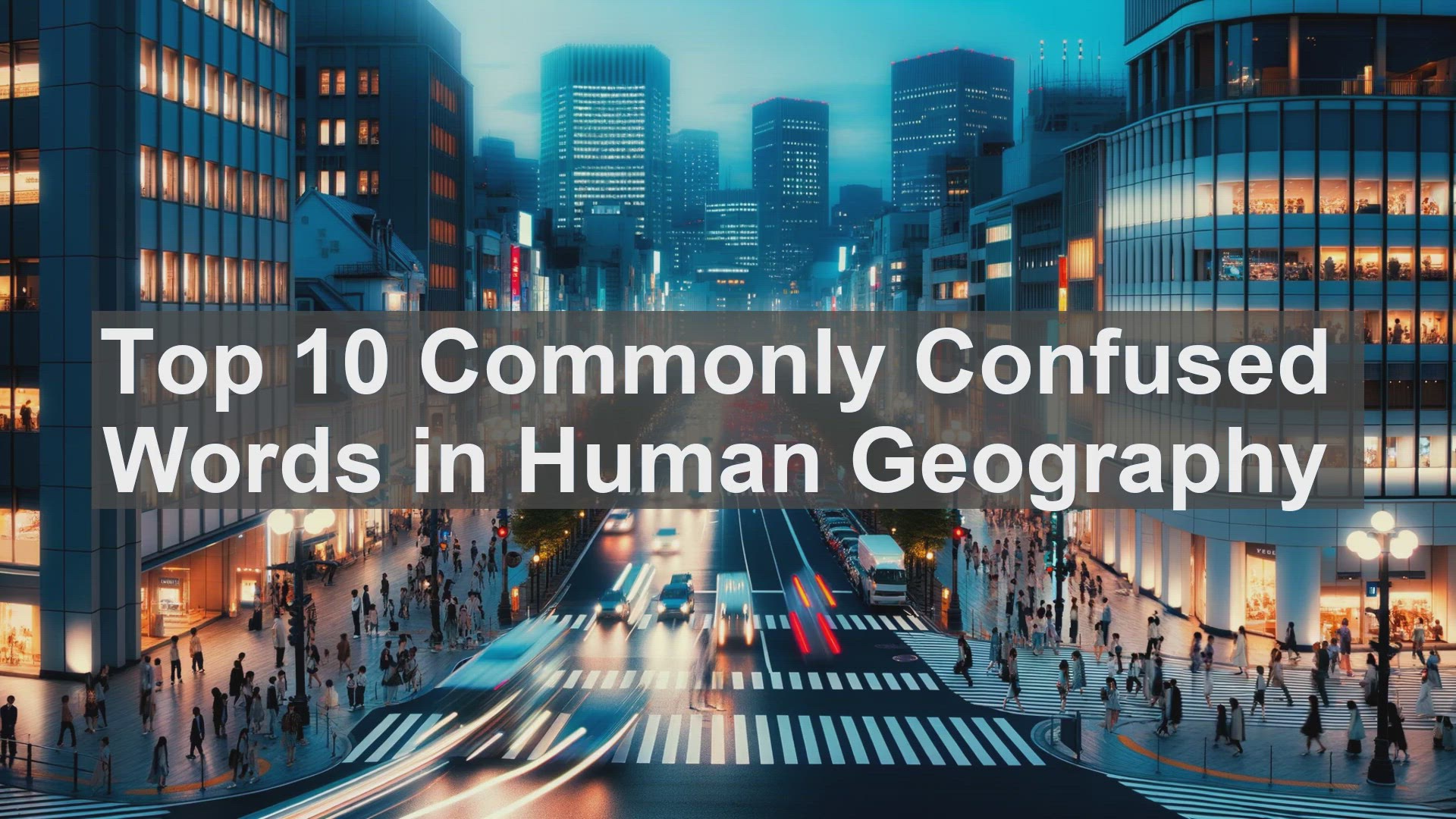
Top 10 Commonly Confused Words in Human Geography
8K views · Dec 5, 2023 englishteststore.net
Top 10 Commonly Confused Words in Human Geography 1. Urbanization vs. Suburbanization Urbanization and suburbanization are two terms that are often used interchangeably, but they have distinct meanings. Urbanization refers to the process of an area becoming more urban, with an increase in population, infrastructure, and economic activities. On the other hand, suburbanization is the outward expansion of cities, leading to the development of suburbs. While both involve changes in the urban landscape, they represent different patterns and dynamics. 2. Globalization vs. Localization Globalization and localization are concepts that deal with the interconnectedness of the world. Globalization refers to the integration of economies, cultures, and societies on a global scale. It emphasizes the interdependence and flow of ideas, goods, and people across borders. Localization, on the other hand, emphasizes the preservation of local cultures, traditions, and economies. It is about maintaining distinct identities in the face of globalization. Both are important, but they represent different approaches to the global-local dynamic. 3. Weather vs. Climate Weather and climate are terms that are often used interchangeably, but they refer to different temporal scales. Weather is the day-to-day atmospheric conditions, including temperature, precipitation, and wind patterns. It is what we experience on a daily basis. Climate, on the other hand, is the long-term average of weather patterns in a particular region. It is the overall trend over a period of years or even centuries. Understanding the difference between weather and climate is crucial in studying the Earth's climate system. 4. Migration vs. Immigration Migration and immigration are terms that deal with the movement of people, but they have different perspectives. Migration is a broader term that encompasses any movement of people from one place to another, whether it is within a country or across international borders. Immigration, on the other hand, specifically refers to the movement of people into a country with the intention of settling there. It is a subset of migration. Both migration and immigration have significant social, economic, and political implications. 5. Formal vs. Functional Regions Formal and functional regions are concepts used in geography to understand spatial patterns. A formal region is a defined area with a common characteristic, such as a political boundary or a climate zone. It has clear boundaries. A functional region, on the other hand, is defined by a particular function or activity that occurs within it. It is centered around a node or a focal point. Understanding the distinction between formal and functional regions helps in analyzing spatial relationships and patterns. 6. Demographics vs. Population Dynamics Demographics and population dynamics are terms that deal with the study of populations, but they focus on different aspects. Demographics is the statistical study of population characteristics, such as age, gender, and income. It provides a snapshot of the population at a given time. Population dynamics, on the other hand, is concerned with the processes that shape and change populations over time, such as birth rates, death rates, and migration. It looks at the population from a dynamic perspective. 7. Topography vs. Bathymetry Topography and bathymetry are terms that deal with the physical features of the Earth's surface, but they have different applications. Topography refers to the elevation and relief of the land surface, including mountains, valleys, and plains. It is used to study terrestrial landscapes. Bathymetry, on the other hand, is the measurement of the depth and features of underwater areas, such as oceans and lakes. It is used in the study of marine and aquatic environments. Both provide valuable insights into the Earth's surface. 8. Sovereignty vs. Autonomy Sovereignty and autonomy are terms that deal with political power, but they represent different degrees of control. Sovereignty refers to the supreme authority and independence of a state. It is the highest level of political power, where a state has complete control over its internal and external affairs. Autonomy, on the other hand, refers to a lesser degree of control, where a region or community has some self-governing powers but is still part of a larger political entity. Both sovereignty and autonomy are important in understanding political systems.

Top 10 Commonly Confused Words in Industrial Hygiene
686 views · Dec 5, 2023 englishteststore.net
Top 10 Commonly Confused Words in Industrial Hygiene 1. Exposure vs. Dose The terms 'exposure' and 'dose' are often used interchangeably, but they have distinct meanings. 'Exposure' refers to the contact between a person and a hazardous agent, such as a chemical or a biological substance. On the other hand, 'dose' quantifies the amount of that agent that enters the body. In simple terms, exposure is the potential, while dose is the actual intake. Understanding this difference is crucial for assessing risks and implementing appropriate control measures. 2. Hazard vs. Risk While 'hazard' and 'risk' are related, they represent different aspects. A 'hazard' refers to the inherent potential of something to cause harm. For example, a chemical with high toxicity is considered a hazard. 'Risk,' on the other hand, takes into account the likelihood of harm occurring. It considers factors such as exposure duration and control measures in place. In summary, a hazard is the potential, while risk is the probability of that potential turning into an actual harm. 3. Sensitivity vs. Specificity In the context of testing or monitoring, 'sensitivity' and 'specificity' are essential parameters. 'Sensitivity' measures the ability of a test to correctly identify true positives. It indicates how well a test can detect a particular substance or condition. 'Specificity,' on the other hand, measures the ability to correctly identify true negatives. It indicates how well a test can exclude substances or conditions that are not present. Both parameters are crucial for accurate and reliable results. 4. Ventilation vs. Filtration When it comes to controlling airborne contaminants, 'ventilation' and 'filtration' are two common strategies. 'Ventilation' involves the exchange of indoor and outdoor air, diluting the contaminants and reducing their concentration. 'Filtration,' on the other hand, involves the use of filters to physically remove the contaminants from the air. While both methods are effective, their applicability depends on factors such as the type of contaminant and the ventilation system in place. 5. Monitoring vs. Sampling In the context of assessing workplace hazards, 'monitoring' and 'sampling' are often used. 'Monitoring' refers to the continuous or periodic assessment of a parameter, such as air quality or noise levels. It provides real-time data and helps identify trends. 'Sampling,' on the other hand, involves the collection of representative samples for laboratory analysis. It provides detailed information about the composition and concentration of a particular hazard. 6. PPE vs. Engineering Controls When it comes to hazard control, 'PPE' and 'engineering controls' are two primary approaches. 'PPE,' or personal protective equipment, includes items such as gloves, masks, and goggles. It provides a physical barrier between the worker and the hazard. 'Engineering controls,' on the other hand, are measures implemented at the source or along the pathway to eliminate or minimize the hazard. Examples include ventilation systems and enclosure. While PPE is essential, it should be considered as the last line of defense, with engineering controls prioritized whenever feasible. 7. Acute vs. Chronic When describing the health effects of a hazard, 'acute' and 'chronic' are commonly used. 'Acute' refers to immediate or short-term effects that occur shortly after exposure. Examples include skin irritation or dizziness. 'Chronic,' on the other hand, refers to long-term effects that develop over a prolonged period, often as a result of repeated or continuous exposure. Examples include respiratory diseases or cancer. Understanding these distinctions is crucial for appropriate medical management and preventive measures. 8. Threshold vs. Ceiling Limit In the context of exposure limits, 'threshold' and 'ceiling limit' are important concepts. A 'threshold limit' represents the maximum allowable concentration of a substance in the air, below which it is believed that most workers can be exposed without adverse effects. A 'ceiling limit,' on the other hand, represents an absolute upper limit, beyond which exposure should never occur. It is important to note that for certain substances, even exposures below the threshold limit can still pose risks, especially for sensitive individuals. 9. Biohazard vs. Chemical Hazard In industrial hygiene, we often encounter both 'biohazards' and 'chemical hazards.' 'Biohazards' refer to biological substances, such as bacteria or viruses, that can cause harm to human health.
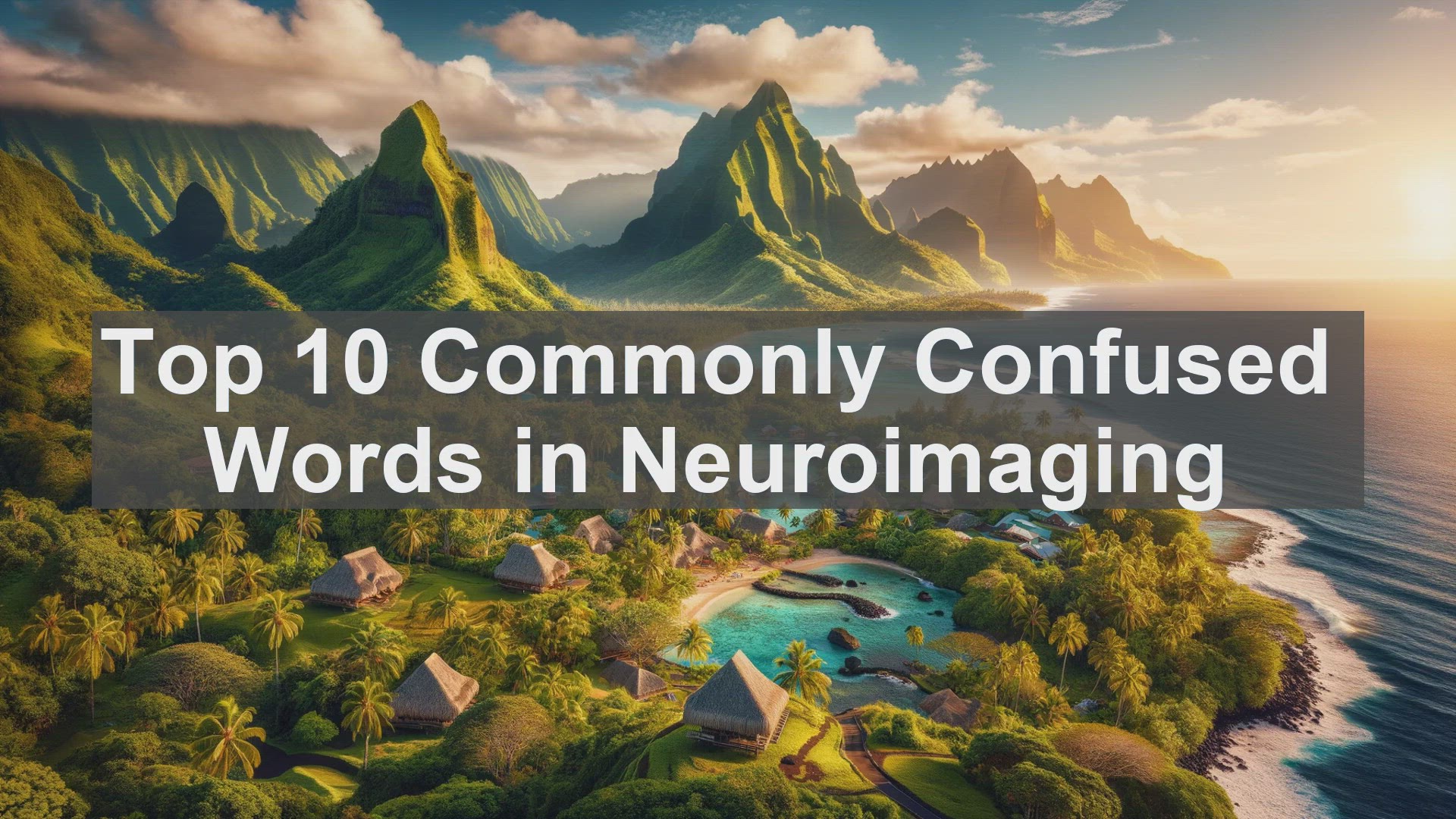
Top 10 Commonly Confused Words in Neuroimaging
330 views · Dec 5, 2023 englishteststore.net
Top 10 Commonly Confused Words in Neuroimaging 1. fMRI vs. MRI First up, we have fMRI and MRI. While both are imaging techniques used in neurology, they serve different purposes. MRI, or Magnetic Resonance Imaging, provides detailed structural images of the brain. On the other hand, fMRI, or functional MRI, measures brain activity by detecting changes in blood flow. So, MRI gives us the 'what' of the brain, while fMRI gives us the 'how' and 'when'. 2. Sensitivity vs. Specificity Next, let's talk about sensitivity and specificity. These terms are often used when discussing the accuracy of a diagnostic test. Sensitivity refers to the test's ability to correctly identify individuals with a particular condition. Specificity, on the other hand, measures the test's ability to correctly identify individuals without the condition. In neuroimaging, both sensitivity and specificity are crucial for accurate diagnoses. 3. Gray Matter vs. White Matter Moving on, we have gray matter and white matter. These are two types of tissue in the brain, and they have distinct functions. Gray matter contains the cell bodies of neurons and is involved in information processing. White matter, on the other hand, consists of nerve fibers and is responsible for transmitting signals between different brain regions. Both gray and white matter play essential roles in brain function. 4. PET vs. SPECT Now, let's compare PET and SPECT. Both are nuclear medicine imaging techniques that involve the use of radioactive tracers. PET, or Positron Emission Tomography, provides functional information by measuring the distribution of the tracer in the body. SPECT, or Single-Photon Emission Computed Tomography, uses a similar principle but with a different type of tracer. Both PET and SPECT have their applications in neuroimaging, depending on the specific clinical question. 5. Sensitivity vs. Resolution In neuroimaging, sensitivity and resolution are two important factors. Sensitivity refers to the ability of the imaging technique to detect subtle changes or abnormalities. Resolution, on the other hand, measures the level of detail that can be captured. While high sensitivity is crucial for detecting small changes, high resolution is necessary for precise localization. The choice of imaging technique often depends on the balance between sensitivity and resolution required for a particular study. 6. Voxel vs. Region of Interest When analyzing neuroimaging data, two common terms are voxel and region of interest. A voxel, short for volume element, is the smallest unit of a three-dimensional image. It's like a pixel in a two-dimensional image. A region of interest, on the other hand, is a specific area or volume within the image that researchers focus on. Both voxels and regions of interest are essential for extracting meaningful information from neuroimaging data. 7. BOLD vs. CBV BOLD and CBV are two types of functional neuroimaging signals. BOLD, which stands for Blood Oxygenation Level Dependent, is based on changes in blood oxygenation. It's the most commonly used signal in fMRI. CBV, or Cerebral Blood Volume, measures the amount of blood in a particular brain region. Both BOLD and CBV provide valuable insights into brain activity, but they capture different aspects of it. 8. Diffusion vs. Perfusion Next, let's discuss diffusion and perfusion. These terms are often used in the context of MRI. Diffusion refers to the movement of water molecules in tissue. It's particularly useful for studying the integrity of white matter tracts. Perfusion, on the other hand, measures the blood flow to a particular area. It's crucial for assessing tissue viability. Both diffusion and perfusion imaging have their applications in various neurological conditions. 9. Artifact vs. Signal When interpreting neuroimaging data, distinguishing between artifacts and signals is essential. An artifact is any unwanted or spurious feature in the image that doesn't reflect the underlying biology. It can be caused by various factors, such as motion or scanner-related issues. A signal, on the other hand, represents the true biological information. Differentiating between artifacts and signals is crucial for accurate data interpretation. 10. ROI vs. Whole-Brain Analysis Lastly, let's talk about ROI and whole-brain analysis. ROI, or Region of Interest analysis, involves focusing on specific brain regions or networks. It's often used when the research question is targeted.
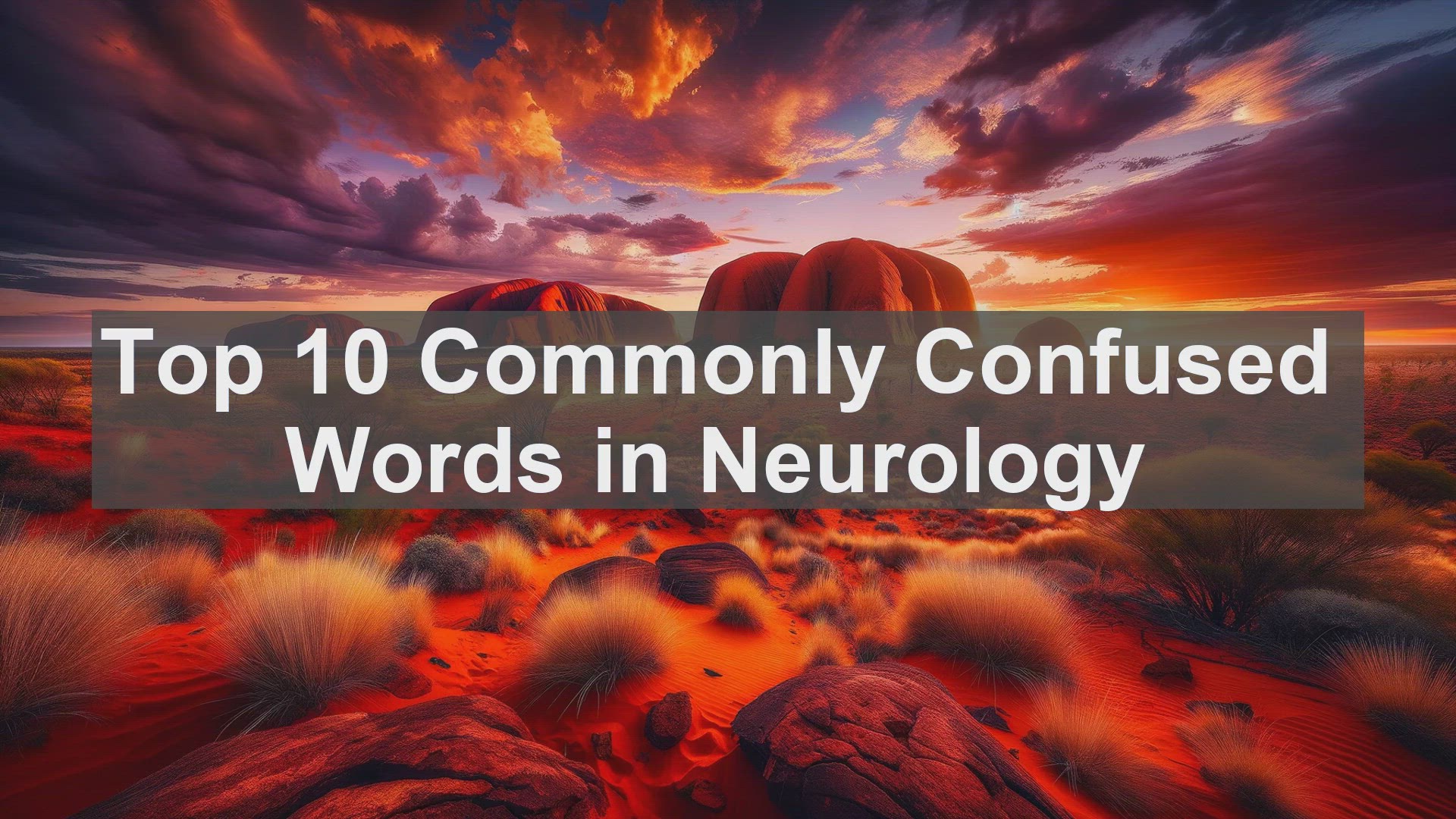
Top 10 Commonly Confused Words in Neurology
372 views · Dec 5, 2023 englishteststore.net
Top 10 Commonly Confused Words in Neurology 1. Synapse vs. Neuron The synapse is the junction between two neurons, allowing for the transmission of signals. On the other hand, a neuron is a specialized cell that transmits these signals. Remember, the synapse is the connection, while the neuron is the cell itself. 2. Cerebrum vs. Cerebellum The cerebrum is the largest part of the brain and is responsible for higher cognitive functions. In contrast, the cerebellum, located at the back, is involved in coordination and balance. Think of the cerebrum as the 'thinking' part and the cerebellum as the 'balancing' part. 3. Gray Matter vs. White Matter Gray matter refers to the regions of the brain and spinal cord that primarily consist of cell bodies and dendrites. In contrast, white matter contains myelinated axons, which facilitate communication between different brain regions. Gray matter is 'cell bodies,' while white matter is 'axons.' 4. Meninges vs. Ventricles The meninges are the protective membranes that surround the brain and spinal cord. On the other hand, ventricles are fluid-filled spaces within the brain. While the meninges provide physical protection, the ventricles help in cushioning and circulating cerebrospinal fluid. 5. Aphasia vs. Apraxia Aphasia is a language disorder that affects a person's ability to communicate. Apraxia, on the other hand, is a motor disorder that impairs the ability to perform purposeful movements. In short, aphasia is about language, while apraxia is about movement. 6. EEG vs. MRI An EEG, or electroencephalogram, measures the electrical activity of the brain using electrodes placed on the scalp. On the other hand, an MRI, or magnetic resonance imaging, uses magnetic fields and radio waves to create detailed images of the brain's structure. EEG is about electrical activity, while MRI is about detailed imaging. 7. Ischemic vs. Hemorrhagic Stroke An ischemic stroke occurs when a blood clot blocks a blood vessel in the brain, leading to reduced blood flow. In contrast, a hemorrhagic stroke happens when a blood vessel ruptures, causing bleeding in the brain. Ischemic stroke is about blockage, while hemorrhagic stroke is about bleeding. 8. Dementia vs. Alzheimer's Dementia is an umbrella term for a decline in cognitive ability, including memory loss and problem-solving difficulties. Alzheimer's disease is the most common cause of dementia and is characterized by the accumulation of abnormal proteins in the brain. Dementia is the broader term, while Alzheimer's is a specific type. 9. Myelin vs. Axon The axon is a long, slender projection of a neuron that transmits electrical signals. Myelin is a fatty substance that wraps around the axon, providing insulation and speeding up signal transmission. The axon is the 'wire,' while myelin is the 'insulation.' 10. Neurotransmitter vs. Hormone Neurotransmitters are chemical messengers that transmit signals across synapses in the nervous system. Hormones, on the other hand, are chemical messengers that travel through the bloodstream to target cells or organs. Neurotransmitters are for local communication, while hormones are for widespread communication. Conclusion And there you have it, the top 10 commonly confused words in neurology. By understanding these distinctions, you'll be well-equipped to navigate the intricate world of neurology. Keep exploring, keep learning, and soon, you'll be making significant contributions to this field. Thank you for watching!
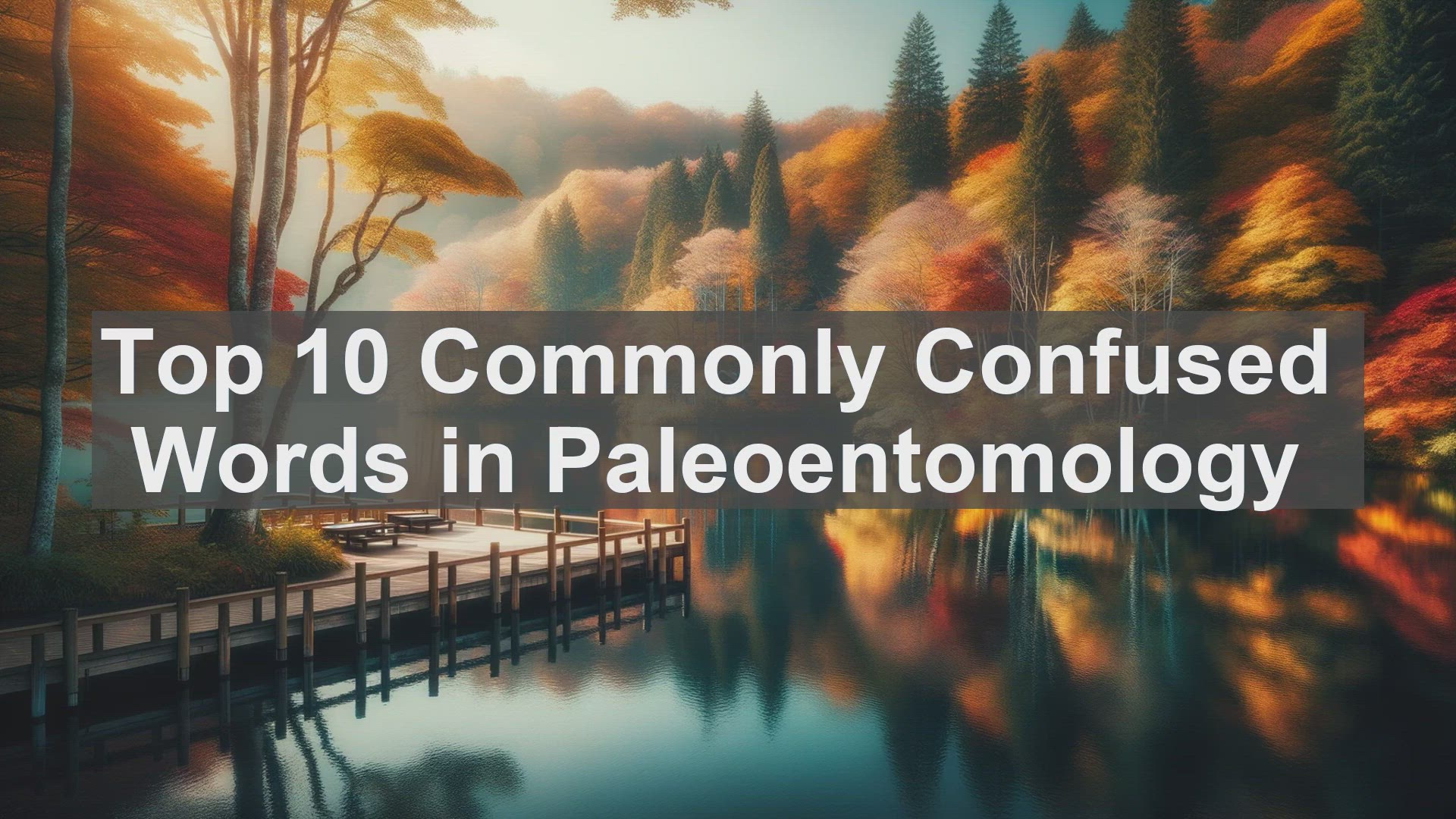
Top 10 Commonly Confused Words in Paleoentomology
1K views · Dec 5, 2023 englishteststore.net
Top 10 Commonly Confused Words in Paleoentomology 1. Fossil vs. Trace Fossil One of the first distinctions to understand is between a fossil and a trace fossil. A fossil is the preserved remains of an organism, while a trace fossil is evidence of an organism's activity, such as footprints or burrows. Both provide valuable insights into the ancient insect world. 2. Exoskeleton vs. Endoskeleton Insects, including their ancient counterparts, have exoskeletons, which are external hard coverings that provide support and protection. On the other hand, vertebrates, like us, have endoskeletons, which are internal frameworks. The exoskeleton is a defining feature of insects. 3. Extinct vs. Extirpated When we say a species is extinct, it means it no longer exists anywhere on Earth. However, if a species is extirpated, it means it is locally extinct, but still found in other regions. Understanding these terms helps us track the distribution of ancient insect species. 4. Taxonomy vs. Phylogeny Taxonomy and phylogeny are both concerned with classifying organisms, but they differ in approach. Taxonomy focuses on categorizing based on shared characteristics, while phylogeny looks at evolutionary relationships. Both are crucial for organizing the vast diversity of ancient insects. 5. Incomplete vs. Complete Metamorphosis Metamorphosis is a fascinating process in insect development. Incomplete metamorphosis involves three stages: egg, nymph, and adult. Complete metamorphosis, on the other hand, has four stages: egg, larva, pupa, and adult. Understanding these stages aids in identifying ancient insect fossils. 6. Autecology vs. Synecology When studying ancient insect species, it's essential to consider their ecological roles. Autecology focuses on the individual species' interactions with the environment, while synecology looks at the relationships between multiple species in a community. Both provide valuable insights. 7. Taphonomy vs. Paleobiology Taphonomy and paleobiology are two branches of paleoentomology. Taphonomy examines the processes that affect an organism from death to fossilization, while paleobiology explores the biology and behavior of ancient insects. Together, they help us reconstruct the past. 8. Holotype vs. Paratype When a new species is discovered, specimens are designated as holotype or paratype. The holotype is the primary specimen used to define the species, while paratypes are additional specimens that share similar characteristics. These designations ensure clarity in species identification. 9. Ichnotaxon vs. Body Fossil In paleoentomology, we encounter both ichnotaxa and body fossils. An ichnotaxon refers to a trace fossil, such as a burrow, while a body fossil is the preserved remains of the actual organism. Both provide different types of information about ancient insects. 10. Infauna vs. Epifauna When studying ancient insect communities, we distinguish between infauna and epifauna. Infauna refers to organisms that live within the sediment, while epifauna are those that live on top of the sediment. This differentiation helps us understand ancient habitats. Conclusion And that concludes our exploration of the top 10 commonly confused words in paleoentomology. By mastering these terms, you'll have a solid foundation for further studies in this captivating field. Happy paleoentomology adventures, and see you next time!
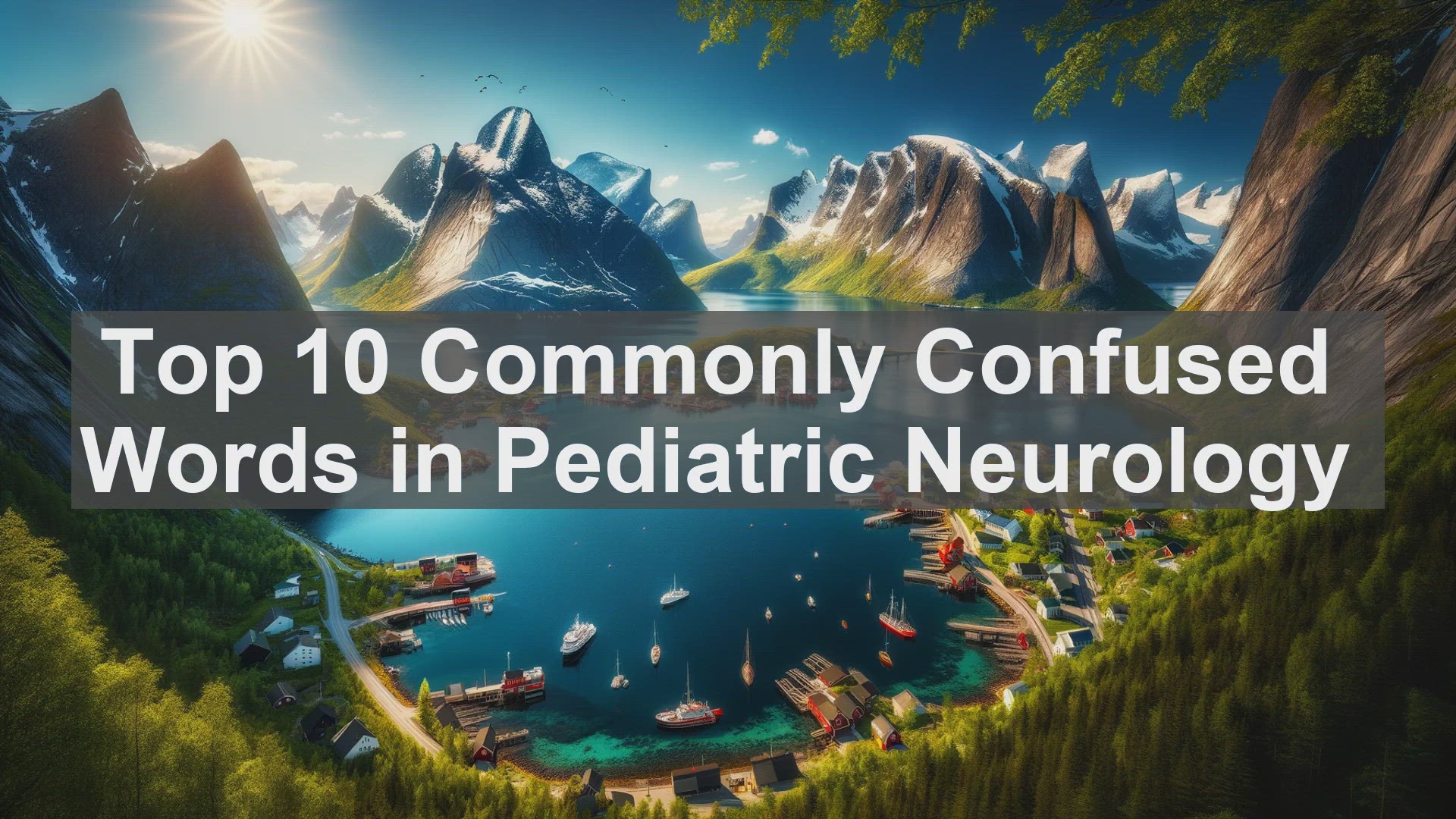
Top 10 Commonly Confused Words in Pediatric Neurology
843 views · Dec 5, 2023 englishteststore.net
Top 10 Commonly Confused Words in Pediatric Neurology 1. Seizure vs. Epilepsy Seizure and epilepsy are often used interchangeably, but they're not the same. A seizure is a single event characterized by abnormal electrical activity in the brain. On the other hand, epilepsy is a chronic condition where a person experiences recurrent seizures. So, think of a seizure as a one-time occurrence, while epilepsy involves repeated episodes. 2. Paralysis vs. Paresis Paralysis and paresis both refer to a loss of muscle function, but there's a distinction. Paralysis means complete loss of muscle movement, whereas paresis indicates partial loss or weakness. For example, a person with paralysis may be unable to move a limb at all, while someone with paresis may have limited movement or reduced strength in that limb. 3. Coma vs. Vegetative State Coma and vegetative state are terms used to describe altered states of consciousness, but they differ in important ways. A coma is a deep state of unconsciousness where the person is unresponsive and unaware of their surroundings. In contrast, a vegetative state involves periods of wakefulness, but the person remains unaware and shows no signs of meaningful interaction. It's like being awake but not truly 'there.' 4. Meningitis vs. Encephalitis Meningitis and encephalitis are both infections that affect the brain, but they target different areas. Meningitis primarily involves the inflammation of the meninges, the protective membranes around the brain and spinal cord. Encephalitis, on the other hand, refers to the inflammation of the brain tissue itself. While they can have overlapping symptoms, the underlying causes and treatments may vary. 5. Ataxia vs. Athetosis Ataxia and athetosis are both movement disorders, but they manifest differently. Ataxia is characterized by uncoordinated movements, often described as 'clumsiness.' Athetosis, on the other hand, involves slow, involuntary, and writhing movements, particularly in the hands and fingers. So, while ataxia affects coordination, athetosis is more about abnormal, involuntary motions. 6. Hydrocephalus vs. Meningocele Hydrocephalus and meningocele are conditions related to the central nervous system, but they're distinct. Hydrocephalus refers to the buildup of excess cerebrospinal fluid in the brain, leading to increased pressure. Meningocele, on the other hand, is a type of spina bifida where the protective covering of the spinal cord protrudes through an opening in the spine. While both require medical attention, they involve different areas. 7. Myelitis vs. Myelopathy Myelitis and myelopathy both involve the spinal cord, but they're not the same. Myelitis refers to the inflammation of the spinal cord, often caused by infections or autoimmune conditions. Myelopathy, on the other hand, is a more general term that encompasses any disease or disorder affecting the spinal cord. So, myelitis is a specific type of myelopathy, but not all myelopathies are myelitis. 8. Neuron vs. Nerve Neurons and nerves are both crucial components of the nervous system, but they have different roles. Neurons are the basic building blocks of the nervous system, responsible for transmitting and processing information. Nerves, on the other hand, are bundles of fibers that contain multiple neurons. Think of neurons as the individual workers, and nerves as the communication cables that connect them. 9. Ischemia vs. Hemorrhage Ischemia and hemorrhage are both types of strokes, but they involve different mechanisms. Ischemic strokes occur when a blood clot blocks a blood vessel, cutting off the blood supply to a part of the brain. Hemorrhagic strokes, on the other hand, happen when a blood vessel ruptures, leading to bleeding in the brain. While the end result is similar - brain damage - the causes and treatments differ. 10. Dementia vs. Delirium Dementia and delirium are both conditions that affect cognition, but they have distinct features. Dementia is a progressive, chronic condition characterized by a decline in memory, thinking, and reasoning abilities. Delirium, on the other hand, is an acute and often reversible state of confusion and disorientation. It can be caused by various factors, such as infections or medication side effects. Unlike dementia, delirium is usually temporary. Conclusion And there you have it - the top 10 commonly confused words in pediatric neurology. By understanding these distinctions, you'll be better equipped to navigate the intricacies of this field.
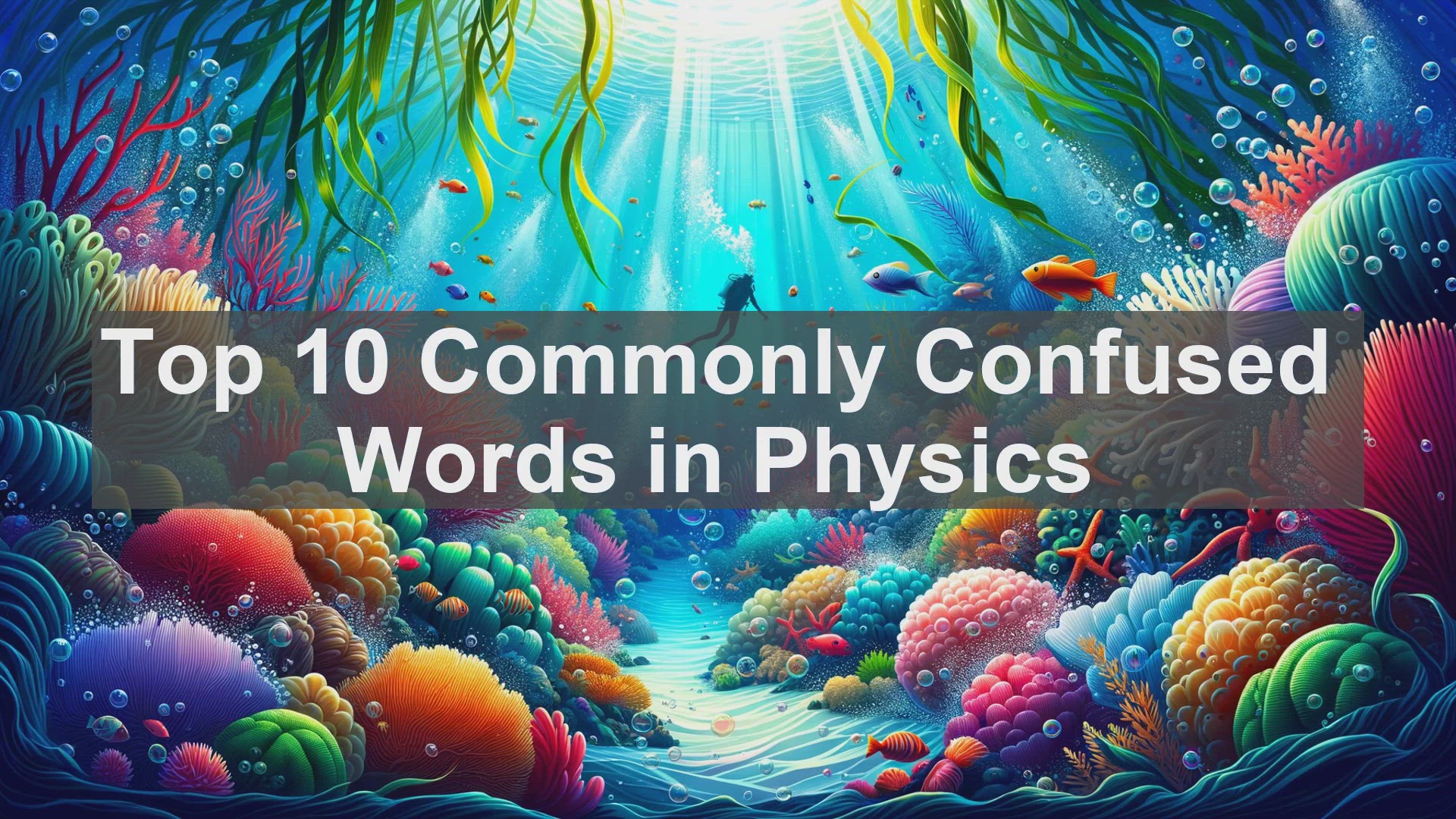
Top 10 Commonly Confused Words in Physics
182 views · Dec 5, 2023 englishteststore.net
Top 10 Commonly Confused Words in Physics 1. Mass vs. Weight The terms 'mass' and 'weight' are often used interchangeably, but they have distinct meanings. Mass refers to the amount of matter in an object, while weight is the force exerted on an object due to gravity. In simpler terms, mass is constant, but weight can vary depending on the gravitational pull. For example, your mass will remain the same on Earth and the Moon, but your weight will be different due to the Moon's lower gravity. 2. Velocity vs. Speed Velocity and speed both refer to how fast an object is moving, but they differ in one crucial aspect: direction. Speed is a scalar quantity, meaning it only has magnitude, while velocity is a vector quantity, having both magnitude and direction. For instance, if you're driving at 60 km/h north, your speed is 60 km/h, and your velocity is 60 km/h north. It's essential to consider direction when dealing with velocity. 3. Distance vs. Displacement Distance and displacement are often used interchangeably, but they represent different concepts. Distance is the total length covered by an object, regardless of direction. Displacement, on the other hand, is the change in position from the starting point to the endpoint, considering direction. For example, if you walk 10 meters forward and then 10 meters back, your distance covered is 20 meters, but your displacement is 0 since you returned to the starting point. 4. Work vs. Power Work and power are related to the transfer of energy, but they have distinct meanings. Work is the transfer of energy that occurs when a force is applied to an object, causing it to move. Power, on the other hand, is the rate at which work is done or energy is transferred. In simpler terms, work is the total amount of energy transferred, while power is how quickly it is transferred. A simple analogy is lifting a heavy box (work) versus how quickly you can lift multiple boxes (power). 5. Conduction vs. Convection Conduction and convection are two methods of heat transfer. Conduction occurs when heat is transferred through direct contact between objects. For example, if you touch a hot pan, the heat is transferred through conduction. Convection, on the other hand, involves the transfer of heat through the movement of a fluid, such as air or water. A classic example is a pot of boiling water, where the heat is transferred through convection currents in the water. 6. Reflection vs. Refraction Reflection and refraction are phenomena related to the behavior of light. Reflection occurs when light bounces off a surface, such as a mirror. Refraction, on the other hand, happens when light passes through a medium and changes direction. A common example of refraction is the bending of light when it passes from air to water, causing objects to appear shifted. Both reflection and refraction play crucial roles in optics and the formation of images. 7. Voltage vs. Current Voltage and current are fundamental concepts in electricity. Voltage, measured in volts, is the potential difference between two points in an electrical circuit. It's analogous to the pressure in a water pipe. Current, measured in amperes, is the flow of electric charge, similar to the rate of water flow in a pipe. In simpler terms, voltage is the 'push' that causes current to flow. Understanding the relationship between voltage and current is essential in electrical circuits. 8. Kinetic Energy vs. Potential Energy Kinetic energy and potential energy are two forms of energy an object can possess. Kinetic energy is the energy of motion, while potential energy is the energy an object has due to its position or state. For example, a moving car has kinetic energy, while a stretched spring has potential energy. The interconversion between kinetic and potential energy is a fundamental concept in physics, as seen in simple pendulums or roller coasters. 9. Frequency vs. Period Frequency and period are terms used when discussing waves. Frequency, measured in hertz, is the number of complete cycles of a wave that occur in one second. Period, measured in seconds, is the time it takes for one complete cycle. They are inversely related, meaning as frequency increases, the period decreases, and vice versa. Understanding the relationship between frequency and period is crucial in wave analysis and applications, such as in radio or sound waves. 10. Acceleration vs. Deceleration Acceleration and deceleration both refer to changes in an object's velocity, but they have opposite meanings.

Top 10 Commonly Confused Words in Plant Biophysics
1K views · Dec 5, 2023 englishteststore.net
Top 10 Commonly Confused Words in Plant Biophysics 1. Transpiration vs. Evaporation Transpiration and evaporation are terms that are often used interchangeably, but they have distinct meanings. Transpiration refers to the process by which plants lose water through their leaves. It's a vital mechanism for nutrient uptake and temperature regulation. On the other hand, evaporation is the conversion of liquid water into vapor, usually occurring from non-living surfaces like soil or water bodies. While both involve water loss, the driving forces and contexts differ. 2. Photosynthesis vs. Respiration Photosynthesis and respiration are fundamental processes in a plant's life. Photosynthesis is the process by which plants convert light energy into chemical energy, producing glucose and releasing oxygen. It's a key contributor to the Earth's oxygen levels. Respiration, on the other hand, is the process by which plants break down glucose to release energy for their metabolic activities. While photosynthesis occurs in the presence of light, respiration occurs continuously. 3. Tropism vs. Nastic Movements Plants exhibit various movements in response to stimuli. Tropism refers to the growth or movement of a plant in response to a directional stimulus, such as light or gravity. For example, phototropism is the bending of a plant towards light. Nastic movements, on the other hand, are non-directional responses to stimuli, typically reversible. An example is the closing of a Venus flytrap's leaves when triggered. Both tropism and nastic movements are fascinating adaptations. 4. Xylem vs. Phloem Xylem and phloem are two types of vascular tissues in plants. Xylem is responsible for transporting water and minerals from the roots to the rest of the plant. It's like the plant's plumbing system. Phloem, on the other hand, transports sugars and other organic compounds, such as hormones, to different parts of the plant. It's like the plant's highway for nutrient distribution. Both xylem and phloem are crucial for a plant's survival and growth. 5. Stomata vs. Lenticels Stomata and lenticels are structures involved in gas exchange in plants. Stomata are tiny openings, primarily found on the underside of leaves. They regulate the entry of gases, such as carbon dioxide and oxygen, and the exit of water vapor. Lenticels, on the other hand, are small openings in the bark of woody stems and roots. They allow for gas exchange in older, non-photosynthetic tissues. Both stomata and lenticels play vital roles in maintaining plant health. 6. Gravitropism vs. Thigmotropism Plants have fascinating responses to gravity and touch. Gravitropism is the growth or movement of a plant in response to gravity. For example, roots exhibit positive gravitropism, growing downwards. Thigmotropism, on the other hand, is the growth or movement of a plant in response to touch or mechanical stimulation. An example is a vine wrapping around a support structure. Both gravitropism and thigmotropism are essential for a plant's anchorage and orientation. 7. Auxin vs. Gibberellin Auxin and gibberellin are plant hormones that regulate various growth processes. Auxin is primarily involved in cell elongation, root development, and tropic responses. It's like the plant's growth hormone. Gibberellin, on the other hand, promotes stem elongation, seed germination, and flowering. It's like the plant's development hormone. Both auxin and gibberellin, along with other hormones, orchestrate the complex growth and development patterns we observe in plants. 8. Chlorophyll vs. Carotenoid Chlorophyll and carotenoid are pigments involved in photosynthesis. Chlorophyll, with its green color, is the primary pigment that captures light energy. It's like the plant's solar panel. Carotenoids, on the other hand, have various colors, including red, orange, and yellow. They act as accessory pigments, broadening the range of light wavelengths that can be absorbed. Both chlorophyll and carotenoids are essential for efficient light capture during photosynthesis. 9. Apical Meristem vs. Lateral Meristem Meristems are regions of active cell division in plants, responsible for growth and development. Apical meristem, found at the tips of roots and shoots, is involved in primary growth, leading to an increase in length. Lateral meristem, such as the cambium, is responsible for secondary growth, leading to an increase in girth or thickness. Both apical and lateral meristems contribute to the overall growth and form of a plant.
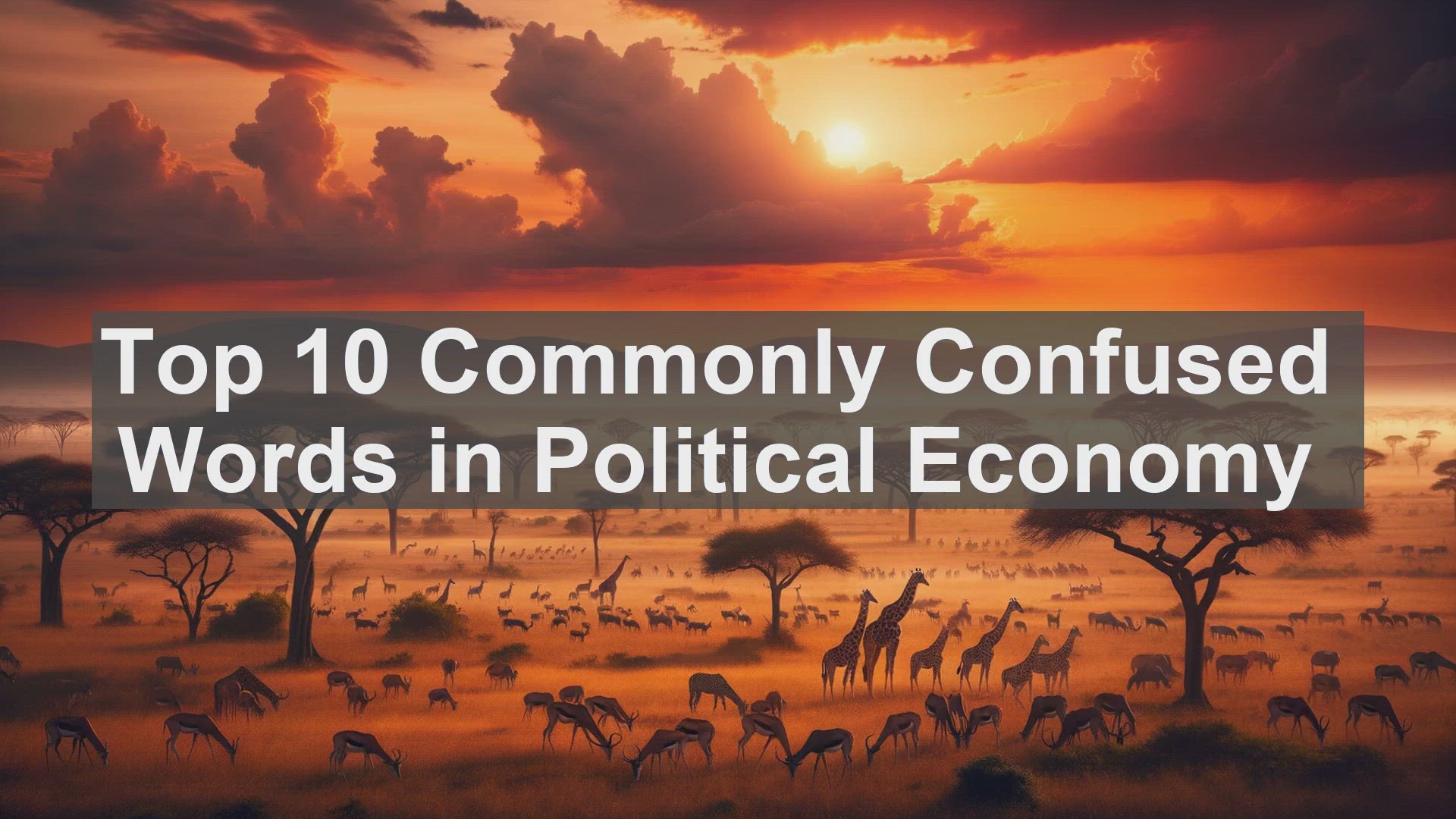
Top 10 Commonly Confused Words in Political Economy
7K views · Dec 5, 2023 englishteststore.net
Top 10 Commonly Confused Words in Political Economy 1. Capitalism vs. Socialism Capitalism and socialism are often used interchangeably, but they represent distinct economic systems. Capitalism emphasizes private ownership and free markets, while socialism focuses on collective ownership and centralized planning. 2. Fiscal Policy vs. Monetary Policy Fiscal policy refers to government actions related to taxation and spending, while monetary policy involves the management of the money supply and interest rates by the central bank. Both policies aim to influence the economy, but through different channels. 3. Inflation vs. Deflation Inflation refers to a general increase in prices, reducing the purchasing power of money. Deflation, on the other hand, is a decrease in prices. Both have significant implications for the economy, including consumption and investment patterns. 4. Austerity vs. Stimulus During economic downturns, policymakers often debate between austerity and stimulus measures. Austerity involves reducing government spending to control debt, while stimulus refers to increased spending or tax cuts to boost economic activity. 5. Trade Surplus vs. Trade Deficit When a country exports more than it imports, it has a trade surplus. Conversely, a trade deficit occurs when imports exceed exports. Understanding these terms is vital for comprehending a nation's economic relationships with others. 6. Globalization vs. Protectionism Globalization refers to the increasing interconnectedness of economies through trade and investment. Protectionism, on the other hand, advocates for barriers to foreign competition. These concepts often arise in discussions about international trade. 7. Neoliberalism vs. Classical Liberalism Neoliberalism, a term often used in contemporary discourse, emphasizes free markets and limited government intervention. Classical liberalism, on the other hand, emerged in the 18th century and shares similar principles. Understanding their nuances is essential. 8. Regressive Tax vs. Progressive Tax Regressive taxes, such as sales tax, take a larger proportion of income from low-income individuals. Progressive taxes, like income tax, have higher rates for higher income brackets. These tax systems have different distributional effects. 9. Public Good vs. Private Good Public goods, like national defense, benefit society as a whole and are non-excludable. Private goods, such as a car, are excludable and only benefit the owner. Understanding this distinction is crucial for discussions on government intervention. 10. Monopoly vs. Oligopoly Monopoly refers to a market with a single dominant firm, while oligopoly involves a small number of large firms. Both market structures have implications for competition and pricing. Recognizing their differences is vital for antitrust policies. Conclusion: Enhancing Your Understanding By clarifying these commonly confused words, we hope to enhance your understanding of political economy. Remember, precise terminology is the foundation for meaningful discussions and analysis in this field. Keep exploring and learning!

Top 10 Commonly Confused Words in Population Studies
15K views · Dec 5, 2023 englishteststore.net
Top 10 Commonly Confused Words in Population Studies 1. Population vs. Sample One of the fundamental distinctions in population studies is between a population and a sample. A population refers to the entire group we're interested in, while a sample is a subset of that group. For example, if we're studying the average income of a country, the entire country's population is our focus. However, due to practical constraints, we often work with a smaller sample. 2. Birth Rate vs. Fertility Rate While these terms are related to reproduction, they have distinct meanings. Birth rate refers to the number of live births per 1,000 people in a given year. On the other hand, fertility rate is the average number of children a woman is expected to have in her lifetime. So, birth rate gives us a snapshot of the current situation, while fertility rate provides a projection for the future. 3. Immigration vs. Emigration These terms deal with the movement of people across borders. Immigration refers to individuals coming into a country, while emigration is the act of leaving one's country to settle elsewhere. Together, these factors contribute to a country's net migration rate, which can have significant social and economic implications. 4. Urbanization vs. Rural-Urban Migration Urbanization refers to the overall process of a population shifting from rural to urban areas. It's a broader concept that encompasses various factors like economic development and infrastructure. On the other hand, rural-urban migration specifically focuses on the movement of individuals from rural to urban regions. Both these trends have far-reaching consequences for a country's social fabric and resource allocation. 5. Life Expectancy vs. Longevity While these terms are often used interchangeably, they have nuanced differences. Life expectancy refers to the average number of years a person is expected to live, usually at birth. It's a statistical measure that takes into account various factors like healthcare and lifestyle. On the other hand, longevity is a broader concept that denotes a long duration of life. It can be influenced by genetic and environmental factors. 6. Demographics vs. Demography Though these terms sound similar, they have distinct meanings. Demographics refers to the characteristics of a population, such as age, gender, and income. It's often used in the context of market research or social studies. Demography, on the other hand, is the scientific study of population, including its size, structure, and distribution. It's a broader field that encompasses various aspects of population dynamics. 7. Population Density vs. Population Distribution Population density refers to the number of people per unit of area, such as square kilometer. It gives us an idea of how crowded or sparse an area is. On the other hand, population distribution refers to how the population is spread out across a given area. It can be even, clustered, or dispersed. Both these measures provide insights into the spatial patterns of a population. 8. Crude Rate vs. Age-Adjusted Rate When analyzing population data, it's essential to consider the impact of age. Crude rate refers to a measure that hasn't been adjusted for age. It's a straightforward calculation that gives us a general idea. However, age-adjusted rate takes into account the age distribution of the population, allowing for more accurate comparisons. This is particularly important when studying health-related indicators. 9. Replacement Level Fertility vs. Zero Population Growth These terms are often used in the context of population stabilization. Replacement level fertility refers to the number of children a couple needs to have to replace themselves. It's usually slightly above 2 due to factors like mortality. On the other hand, zero population growth occurs when the number of births equals the number of deaths, resulting in a stable population size. 10. Dependency Ratio vs. Old-Age Dependency Ratio Dependency ratio is a measure that indicates the proportion of the population that's not in the workforce, typically due to being too young or too old. It's calculated by dividing the dependent population (those not in the workforce) by the working-age population. Old-age dependency ratio specifically focuses on the proportion of elderly individuals. These ratios are crucial for understanding the economic and social implications of an aging population. Conclusion And there you have it, the top 10 commonly confused words in population studies.
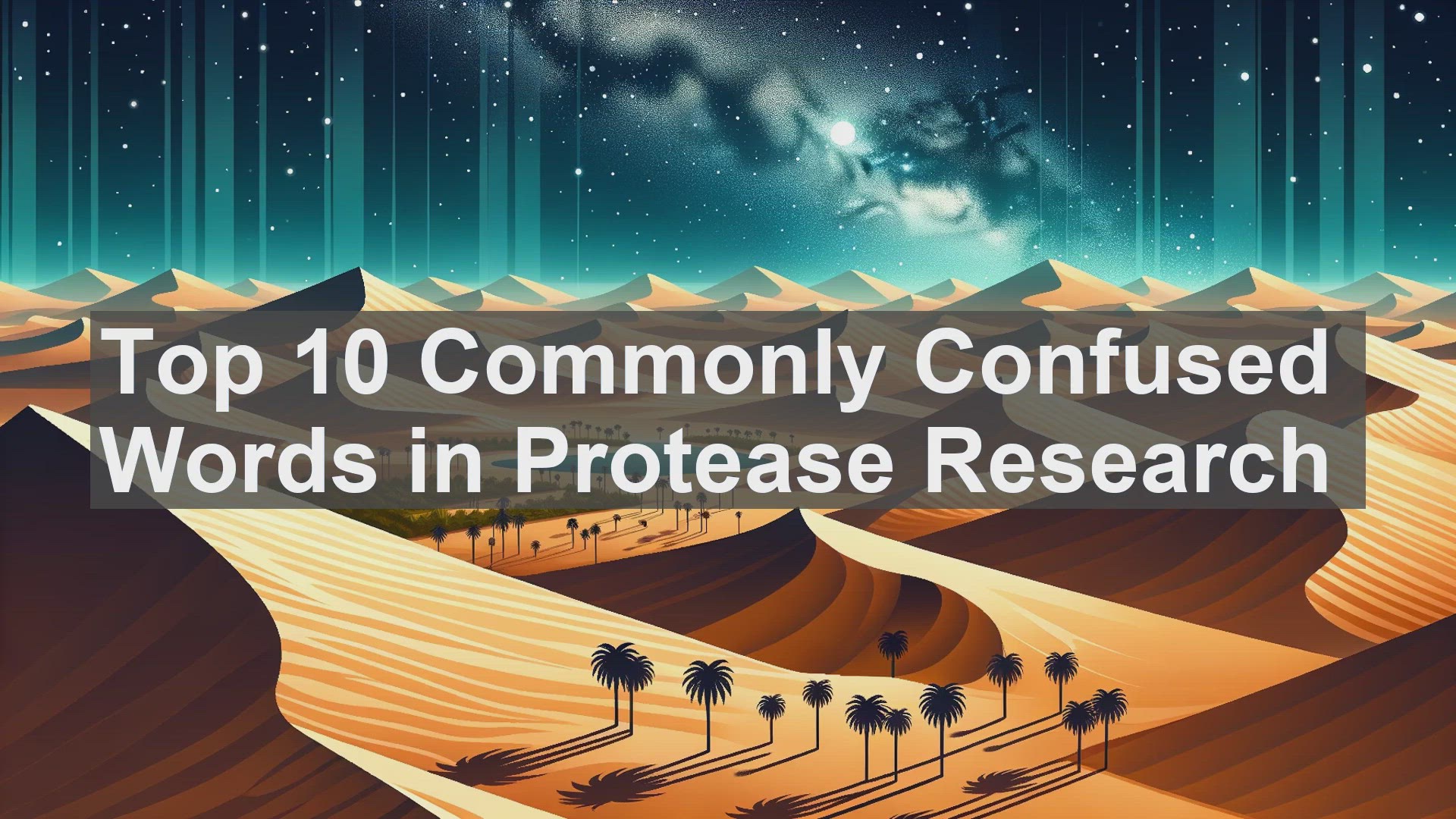
Top 10 Commonly Confused Words in Protease Research
998 views · Dec 5, 2023 englishteststore.net
Top 10 Commonly Confused Words in Protease Research 1. Protease vs. Protein One of the most fundamental distinctions to grasp is the difference between a protease and a protein. While both are involved in the intricate world of molecular biology, a protease is an enzyme that breaks down proteins, whereas a protein is a biomolecule made up of amino acids. Understanding this distinction is crucial as it forms the basis of many research studies. 2. Active Site vs. Allosteric Site When studying the structure of proteases, we often encounter terms like the active site and the allosteric site. The active site is the region of the enzyme where the substrate binds and the catalytic reaction occurs. On the other hand, the allosteric site is a separate site on the enzyme that, when bound by a molecule, can either enhance or inhibit the enzyme's activity. These two sites play distinct roles in the functioning of a protease. 3. Inhibitor vs. Substrate In the context of protease research, an inhibitor and a substrate are terms that are frequently used. An inhibitor is a molecule that binds to the enzyme, preventing it from carrying out its normal function. On the contrary, a substrate is the molecule upon which the enzyme acts, leading to a chemical transformation. Understanding the difference between these two is vital in designing experiments and developing potential therapeutic strategies. 4. Zymogen vs. Active Enzyme Zymogen and active enzyme are terms often encountered when studying proteases. A zymogen, also known as a proenzyme, is an inactive precursor of an enzyme. It requires a specific cleavage event to become an active enzyme. This mechanism ensures that the enzyme's activity is tightly regulated. Once the zymogen is cleaved, it transforms into an active enzyme, ready to carry out its function. 5. Homodimer vs. Heterodimer Proteases can exist as homodimers or heterodimers. A homodimer is a protein complex composed of two identical subunits, whereas a heterodimer consists of two different subunits. This distinction in the composition of the protease complex can have significant implications on its structure, function, and regulation. 6. Endopeptidase vs. Exopeptidase Endopeptidases and exopeptidases are two types of proteases that differ in their mode of action. An endopeptidase cleaves peptide bonds within the protein chain, resulting in the formation of smaller peptide fragments. In contrast, an exopeptidase cleaves the peptide bonds at the ends of the protein chain. Understanding these distinctions is crucial in studying protease-mediated protein degradation pathways. 7. Specificity vs. Selectivity When discussing proteases, the terms specificity and selectivity often arise. Specificity refers to the ability of a protease to recognize and cleave a particular peptide bond or sequence. Selectivity, on the other hand, encompasses the protease's ability to distinguish between different substrates. These two terms are essential in understanding the intricate network of protease-substrate interactions. 8. Kinetics vs. Thermodynamics In the realm of protease research, both kinetics and thermodynamics play crucial roles. Kinetics deals with the rate at which a reaction occurs, while thermodynamics focuses on the energy changes associated with the reaction. Understanding these concepts is vital in unraveling the complexities of protease catalysis and enzyme regulation. 9. Proteolysis vs. Proteogenesis Proteolysis and proteogenesis are two opposing processes in the world of protease research. Proteolysis involves the breakdown of proteins into smaller fragments, while proteogenesis is the synthesis of new proteins. These two processes are finely balanced in the cell and are essential for maintaining cellular homeostasis. 10. Ubiquitin-Proteasome System vs. Autophagy The ubiquitin-proteasome system and autophagy are two major pathways involved in protein degradation. The ubiquitin-proteasome system is responsible for the selective degradation of short-lived proteins, while autophagy is involved in the degradation of long-lived proteins and organelles. Understanding the differences between these two pathways is crucial in comprehending protein turnover in the cell. Conclusion And that brings us to the end of our discussion on the top 10 commonly confused words in protease research. By clarifying these terms, we hope to have provided you with a solid foundation for your future studies in this field. Remember, mastering the language of protease research is just as important as understanding the concepts themselves.
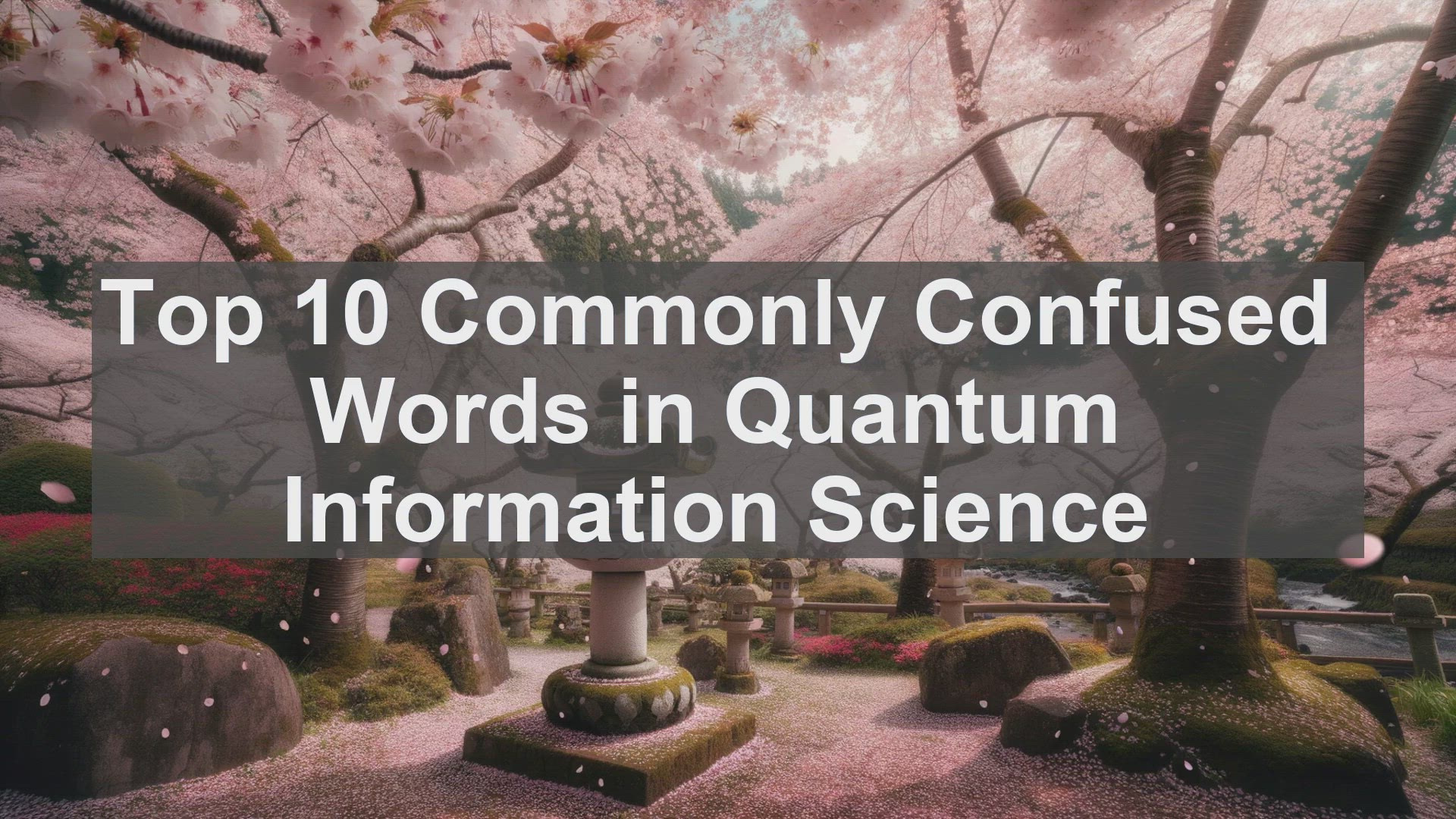
Top 10 Commonly Confused Words in Quantum Information Scienc...
4K views · Dec 5, 2023 englishteststore.net
Top 10 Commonly Confused Words in Quantum Information Science 1. Qubit vs. Classical Bit One of the fundamental distinctions in Quantum Information Science is between qubits and classical bits. While both represent units of information, their underlying principles and behavior differ significantly. Classical bits can only be in one of two states: 0 or 1. In contrast, qubits can exist in a superposition of states, thanks to the principles of quantum mechanics. This property opens the doors to powerful quantum algorithms and computations that surpass classical capabilities. 2. Entanglement vs. Superposition Entanglement and superposition are two cornerstones of quantum phenomena. Superposition refers to the ability of a qubit to be in multiple states simultaneously. Entanglement, on the other hand, describes the intricate correlation between two or more qubits, even when separated by vast distances. This phenomenon, famously referred to as 'spooky action at a distance' by Einstein, has profound implications for quantum communication and cryptography. 3. Quantum Gate vs. Quantum Circuit In the realm of quantum computing, quantum gates and quantum circuits are essential building blocks. A quantum gate is an operation that acts on one or more qubits, transforming their states. A quantum circuit, on the other hand, is a sequence of these gates, representing a quantum algorithm. Just as classical circuits are composed of logic gates, quantum circuits combine various quantum gates to perform computations. 4. Decoherence vs. Error Decoherence and errors are significant challenges in the practical implementation of quantum systems. Decoherence refers to the loss of quantum coherence, resulting in the degradation of qubit states. Errors, on the other hand, can occur during quantum operations, leading to incorrect results. Both decoherence and errors need to be mitigated through error correction techniques to ensure the reliability of quantum computations. 5. Quantum Teleportation vs. Classical Teleportation While the term 'teleportation' might evoke images of science fiction, it has a specific meaning in the quantum realm. Quantum teleportation is the transfer of quantum information from one qubit to another, without physically moving the qubit itself. This process relies on entanglement and is fundamentally different from classical teleportation, which involves the transfer of classical information. 6. Quantum Channel vs. Classical Channel Channels play a crucial role in both classical and quantum communication. A classical channel is a medium through which classical information is transmitted, such as a copper wire or an optical fiber. In contrast, a quantum channel is specifically designed to preserve the delicate quantum states of qubits during transmission. This necessitates specialized techniques, such as quantum error correction, to combat noise and other disturbances. 7. Quantum Cryptography vs. Classical Cryptography Cryptography, the science of secure communication, has undergone a revolution with the advent of quantum computing. Quantum cryptography utilizes the principles of quantum mechanics, such as the no-cloning theorem and the uncertainty principle, to ensure the security of information. Classical cryptography, on the other hand, relies on mathematical algorithms and computational complexity. Quantum cryptography offers the promise of unbreakable encryption, thanks to the laws of quantum physics. 8. Quantum Algorithm vs. Classical Algorithm Algorithms are at the heart of both classical and quantum computing. Classical algorithms, such as sorting or searching, are designed to run on classical computers. Quantum algorithms, on the other hand, leverage the unique properties of qubits, such as superposition and entanglement, to solve specific problems more efficiently. The most famous example is Shor's algorithm, which can factor large numbers exponentially faster than any known classical algorithm, posing a significant threat to classical cryptography. 9. Quantum Simulator vs. Quantum Computer As the name suggests, a quantum simulator is a device or software that emulates the behavior of a quantum system. It's a valuable tool for studying and understanding quantum phenomena, especially when the resources for a full-scale quantum computer are limited. A quantum computer, on the other hand, is a physical system that harnesses the principles of quantum mechanics to perform computations. While still in their infancy, quantum computers hold the promise of revolutionizing fields such as optimization, material science, and drug discovery.
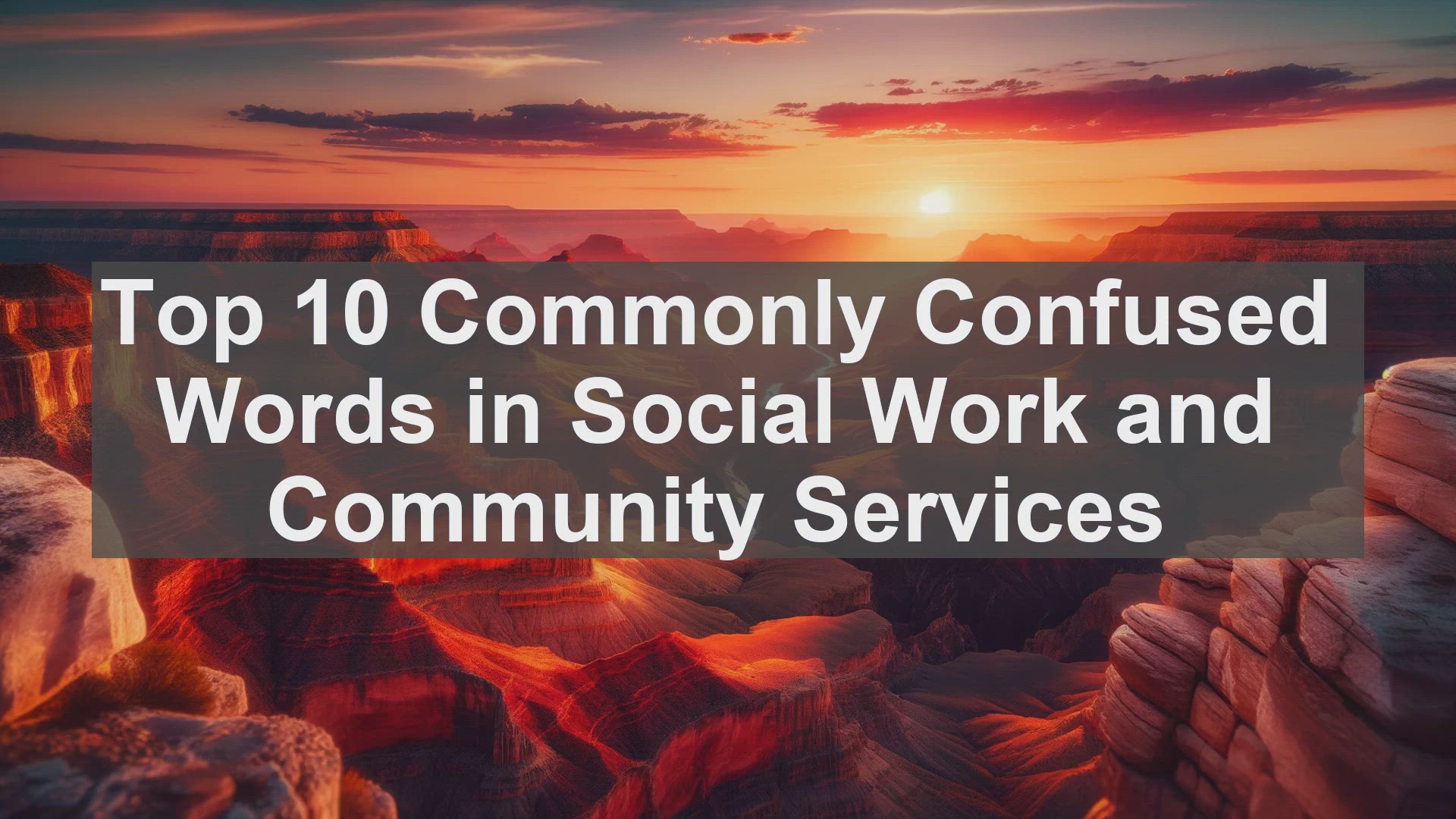
Top 10 Commonly Confused Words in Social Work and Community ...
3K views · Dec 6, 2023 englishteststore.net
Top 10 Commonly Confused Words in Social Work and Community Services 1. Client vs. Customer While both terms refer to individuals receiving a service, 'client' is commonly used in social work, emphasizing the professional relationship. 'Customer' is more business-oriented. So, when discussing your work, 'client' is the appropriate term. 2. Empathy vs. Sympathy These words often intertwine, but they have distinct meanings. 'Empathy' is understanding and sharing someone's feelings, while 'sympathy' is acknowledging and showing concern. In social work, empathy is vital, as it fosters a deeper connection with clients. 3. Confidentiality vs. Privacy In the context of social work, 'confidentiality' refers to the legal and ethical duty to protect client information. 'Privacy' is a broader term, encompassing personal boundaries. Remember, maintaining confidentiality is a cornerstone of trust in this profession. 4. Advocacy vs. Activism Both terms involve supporting a cause, but they differ in approach. 'Advocacy' is about representing and speaking on behalf of others, while 'activism' often involves direct action and public demonstrations. Social workers often engage in advocacy to address systemic issues. 5. Assessment vs. Evaluation In social work, 'assessment' is the initial gathering of information about a client's situation, while 'evaluation' is the ongoing process of determining progress and effectiveness of interventions. Both are essential for informed decision-making. 6. Inclusion vs. Integration While both terms involve incorporating diverse individuals, 'inclusion' emphasizes active participation and equal opportunities, ensuring everyone's voice is heard. 'Integration' refers to the process of merging different groups. In social work, striving for inclusion is key. 7. Resilience vs. Resistance In the face of challenges, 'resilience' is the ability to bounce back and adapt, while 'resistance' is the act of opposing or withstanding. Social workers often focus on fostering resilience in individuals and communities, empowering them to overcome adversity. 8. Intervention vs. Prevention While 'intervention' involves addressing an existing issue, 'prevention' focuses on avoiding or minimizing the occurrence of problems. Social workers engage in both, aiming to provide timely support and also create long-term solutions. 9. Diversity vs. Inclusivity 'Diversity' refers to the range of differences, such as race, gender, and age. 'Inclusivity' goes beyond mere representation, ensuring that diverse individuals feel valued and included. Social workers strive for both diversity and inclusivity in their practice. 10. Collaboration vs. Cooperation While both involve working together, 'collaboration' is a more intensive and equal partnership, often involving shared decision-making. 'Cooperation' is a more general term, indicating working together towards a common goal. Social workers often engage in collaboration, pooling resources and expertise. Conclusion: Enhancing Your Professional Vocabulary By mastering these commonly confused words, you'll not only enhance your communication skills but also convey professionalism in your field. Remember, clear and precise language is the foundation of effective social work and community services. Keep learning, and best of luck in your future endeavors!
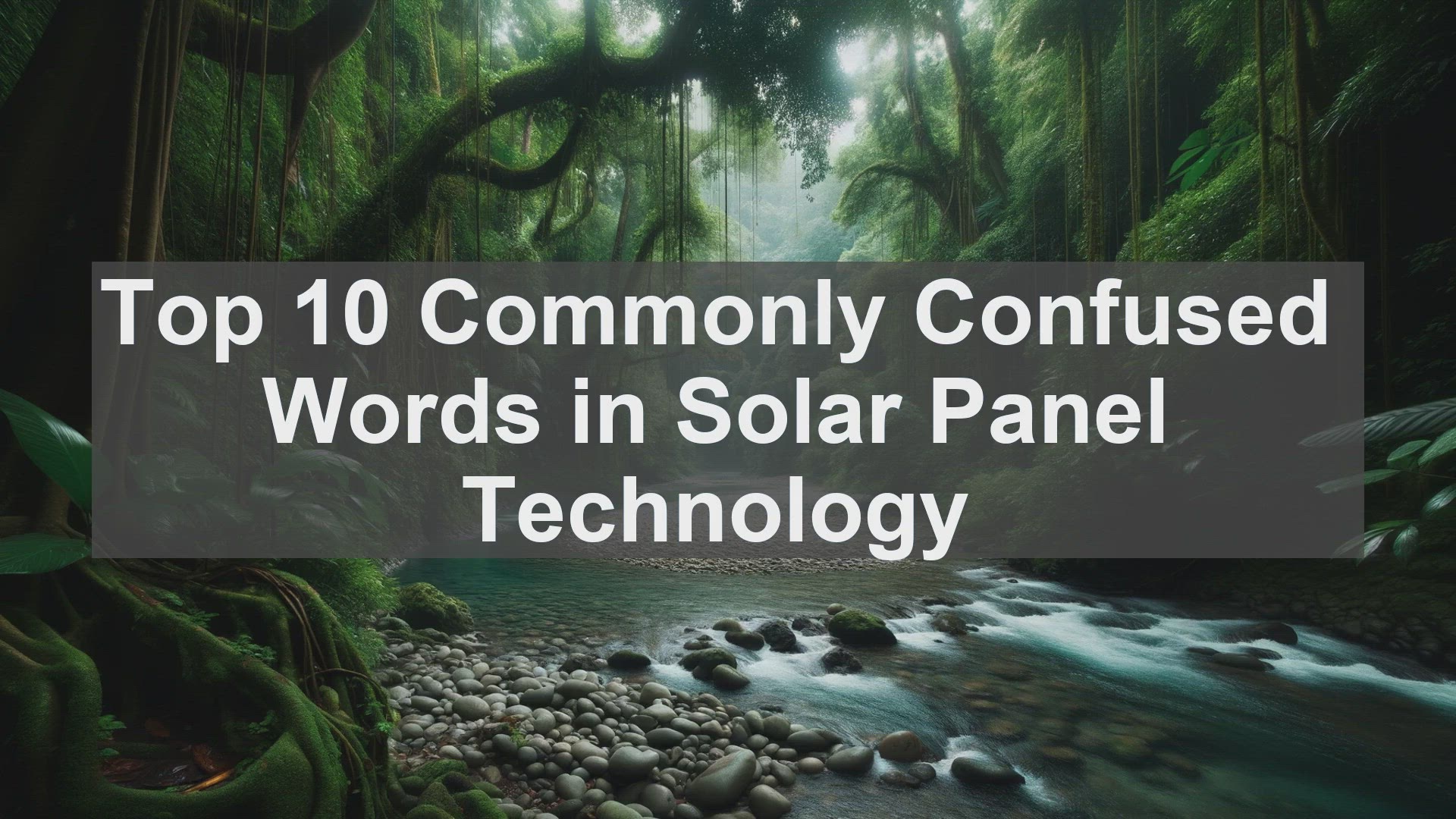
Top 10 Commonly Confused Words in Solar Panel Technology
2K views · Dec 6, 2023 englishteststore.net
Top 10 Commonly Confused Words in Solar Panel Technology 1. Photovoltaic vs. Solar Thermal First up, we have 'photovoltaic' and 'solar thermal.' While both are related to harnessing solar energy, they serve different purposes. Photovoltaic refers to the technology that converts sunlight directly into electricity, commonly seen in solar panels on rooftops. On the other hand, solar thermal involves using the sun's heat for applications like water heating or space heating. So, remember, photovoltaic for electricity and solar thermal for heat. 2. Efficiency vs. Effectiveness Next, let's clarify the difference between 'efficiency' and 'effectiveness.' Efficiency measures how well a solar panel converts sunlight into usable energy, often expressed as a percentage. On the other hand, effectiveness refers to the overall performance of a solar panel system, taking into account factors like maintenance, durability, and cost-effectiveness. So, while efficiency focuses on conversion, effectiveness provides a broader evaluation of the system's capabilities. 3. Monocrystalline vs. Polycrystalline Moving on, we have 'monocrystalline' and 'polycrystalline.' These terms refer to the type of silicon used in solar panels. Monocrystalline panels are made from a single crystal structure, resulting in higher efficiency but also higher costs. Polycrystalline panels, on the other hand, are made from multiple crystal structures, making them more affordable but slightly less efficient. So, it's a trade-off between cost and performance. 4. Grid-Tied vs. Off-Grid Now, let's discuss 'grid-tied' and 'off-grid' systems. A grid-tied solar panel system is connected to the local power grid. It allows you to use solar energy when it's available and draw power from the grid when needed. This setup often includes net metering, where excess energy generated by your panels can be fed back into the grid, earning you credits. In contrast, an off-grid system is independent, relying solely on solar energy and usually incorporating battery storage for backup. So, grid-tied for convenience and off-grid for self-sufficiency. 5. Direct Current (DC) vs. Alternating Current (AC) Let's shed some light on 'direct current' and 'alternating current.' Solar panels produce DC electricity, which is then converted into AC electricity using an inverter. Direct current flows in one direction, while alternating current periodically changes direction. Most household appliances and the power grid operate on AC, so the inverter's role is crucial in making the solar energy usable. Therefore, the conversion from DC to AC is an essential step in the process. 6. Array vs. Module When discussing solar panels, you may come across the terms 'array' and 'module.' An array refers to a group of interconnected solar panels, working together to generate electricity. It's like a collective unit. On the other hand, a module is an individual solar panel, often seen as a rectangular unit. So, while an array is the larger system, a module is a component of that system. 7. Insolation vs. Irradiance Let's differentiate between 'insolation' and 'irradiance.' Insolation refers to the amount of solar energy that reaches a specific area, often measured in kilowatt-hours per square meter per day. It takes into account factors like weather conditions and the position of the sun. Irradiance, on the other hand, measures the power per unit area of solar radiation at a given moment. It's like the intensity of the sunlight. So, insolation for total energy and irradiance for intensity. 8. Tilt vs. Azimuth When it comes to solar panel positioning, we have 'tilt' and 'azimuth.' Tilt refers to the angle at which the solar panels are inclined. This angle is crucial as it determines the panels' exposure to sunlight throughout the day and year. Azimuth, on the other hand, is the compass direction the panels face. It's often expressed in degrees, with south being 180 degrees. So, tilt for angle and azimuth for direction. 9. Amorphous vs. Crystalline Now, let's discuss 'amorphous' and 'crystalline' in the context of solar panels. Amorphous panels are made from non-crystalline silicon, which allows for flexibility and a more uniform appearance. However, they tend to have lower efficiency. Crystalline panels, as the name suggests, are made from crystalline silicon, offering higher efficiency but less flexibility. So, it's a trade-off between flexibility and performance. 10. BIPV vs. Standard Panels Lastly, we have 'BIPV' and 'standard panels.

Top 10 Commonly Confused Words in Space Exploration
2K views · Dec 6, 2023 englishteststore.net
Top 10 Commonly Confused Words in Space Exploration 1. Comet vs. Asteroid Comets and asteroids are often mistaken for one another. While both are celestial objects, comets are composed of ice, dust, and rock, and often have a tail when they approach the Sun. Asteroids, on the other hand, are primarily made up of rock and metal. Understanding this distinction is crucial when studying the origins of our solar system. 2. Galaxy vs. Universe The terms 'galaxy' and 'universe' are sometimes used interchangeably, but they refer to different scales. A galaxy is a vast system of stars, gas, and dust, held together by gravity. Our Milky Way is an example of a galaxy. In contrast, the universe encompasses everything - all the galaxies, stars, planets, and even space itself. It's the entirety of existence as we know it. 3. Rocket vs. Space Shuttle When it comes to space travel, 'rocket' and 'space shuttle' are often confused. A rocket is a vehicle that propels itself by expelling mass in one direction, following Newton's third law of motion. A space shuttle, on the other hand, is a specific type of reusable spacecraft that can transport astronauts and cargo to and from Earth's orbit. While all space shuttles are rockets, not all rockets are space shuttles. 4. Satellite vs. Space Probe Satellites and space probes are both man-made objects sent into space, but their purposes differ. Satellites orbit around a celestial body, such as the Earth, for various applications like communication, weather monitoring, or navigation. Space probes, on the other hand, are designed to explore celestial bodies directly, often by conducting flybys, orbiting, or even landing on them. Think of satellites as 'watchers' and space probes as 'explorers'. 5. Astronaut vs. Cosmonaut The terms 'astronaut' and 'cosmonaut' both refer to individuals who travel to space, but they have different origins. 'Astronaut' is derived from Greek, meaning 'space sailor'. It's the term used by NASA for American space travelers. 'Cosmonaut', on the other hand, comes from Russian and is used by Roscosmos for Russian space travelers. So, while the job is the same, the title differs based on the space agency. 6. Lander vs. Rover When it comes to exploring other planets, 'lander' and 'rover' are often mentioned. A lander is a spacecraft designed to touch down on the surface of a celestial body, like a planet or moon. It remains stationary, conducting experiments and sending data back to Earth. A rover, on the other hand, is a mobile robot that can move across the surface, exploring a wider area. The Mars rovers, such as Curiosity and Perseverance, are great examples. 7. Celestial vs. Terrestrial The terms 'celestial' and 'terrestrial' refer to different realms. 'Celestial' relates to anything in or from space, such as stars, planets, or galaxies. 'Terrestrial', on the other hand, refers to things on Earth's surface. So, when we talk about space exploration, we're primarily dealing with celestial objects and phenomena. 8. Gravity vs. Weightlessness Gravity is the force that attracts objects towards each other. On Earth, it gives us weight, making us feel 'heavy'. However, in space, the sensation of weightlessness can occur. This happens because, while gravity is still present, objects and astronauts are in a state of freefall, constantly falling towards the Earth but also moving forward at such a speed that they keep missing it. This creates the illusion of weightlessness. 9. Exoplanet vs. Extrasolar Planet Both 'exoplanet' and 'extrasolar planet' refer to planets outside our solar system. However, 'exoplanet' is the more commonly used term. It simply means a planet that orbits a star other than our Sun. 'Extrasolar planet' is an older term that was used before the discovery of exoplanets became more frequent. So, when discussing planets beyond our solar system, exoplanet is the word to use. 10. Eclipses: Solar vs. Lunar Solar and lunar eclipses are two captivating celestial events. A solar eclipse occurs when the Moon passes between the Sun and Earth, casting a shadow on our planet. In contrast, a lunar eclipse happens when the Earth is between the Sun and the Moon, causing the Moon to be in Earth's shadow. Remember, during a solar eclipse, it's crucial to use proper eye protection to avoid damaging your eyes. Conclusion And there you have it - the top 10 commonly confused words in space exploration. By understanding these terms, you'll be better equipped to delve into the wonders of the universe.
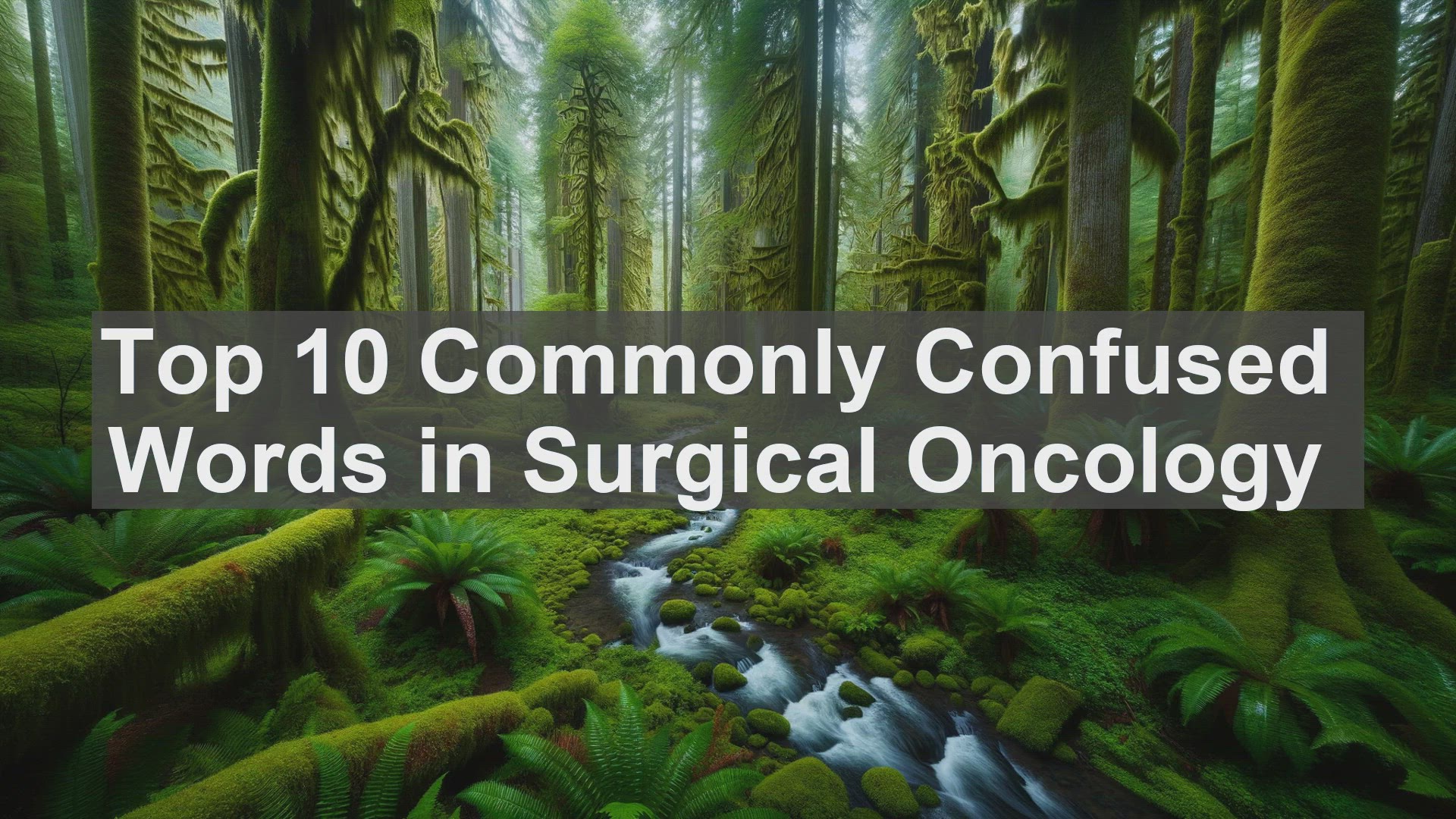
Top 10 Commonly Confused Words in Surgical Oncology
4K views · Dec 6, 2023 englishteststore.net
Top 10 Commonly Confused Words in Surgical Oncology 1. Benign vs. Malignant One of the most fundamental distinctions in surgical oncology is between benign and malignant. While benign tumors are non-cancerous and typically pose no significant threat, malignant tumors are cancerous and can spread to other parts of the body. Understanding this difference is crucial for accurate diagnosis and treatment planning. 2. Metastasis vs. Local Invasion Metastasis and local invasion are often used interchangeably, but they have distinct meanings. Metastasis refers to the spread of cancer cells from the primary site to other parts of the body, while local invasion refers to the cancer cells infiltrating nearby tissues. Recognizing whether a tumor has metastasized or is locally invasive is vital for determining the appropriate treatment approach. 3. Neoplasm vs. Tumor Neoplasm and tumor are frequently used synonymously, but there's a subtle difference. Neoplasm refers to an abnormal growth of cells, which can be benign or malignant. On the other hand, a tumor specifically denotes a swelling caused by an abnormal mass of tissue. While all tumors are neoplasms, not all neoplasms are tumors. 4. Excision vs. Resection Excision and resection are often used interchangeably, but they have different implications. Excision refers to the complete removal of a tissue or organ, whereas resection involves removing a part of it. The choice between excision and resection depends on various factors, such as the tumor's size, location, and the patient's overall health. 5. Palliative vs. Curative Palliative and curative are terms used to describe the intent of a treatment. Palliative treatment aims to alleviate symptoms and improve the patient's quality of life, but it doesn't target the underlying disease. Curative treatment, on the other hand, aims to eliminate the disease entirely. Understanding the difference is crucial for setting realistic treatment goals. 6. Adjuvant vs. Neoadjuvant Adjuvant and neoadjuvant are terms used to describe the timing of a treatment. Adjuvant treatment is given after the primary treatment, such as surgery, to reduce the risk of recurrence. Neoadjuvant treatment, on the other hand, is given before the primary treatment to shrink the tumor, making it more amenable to surgery. The choice between adjuvant and neoadjuvant treatment depends on various factors, including the tumor's size and characteristics. 7. Prognosis vs. Diagnosis Prognosis and diagnosis are often confused, but they refer to different aspects. Diagnosis is the process of identifying a disease or condition, whereas prognosis refers to the likely course and outcome of the disease. While diagnosis is essential for initiating treatment, prognosis provides valuable information about the disease's expected trajectory. 8. Recurrence vs. Relapse Recurrence and relapse are terms used to describe the return of a disease after a period of remission. While they are often used interchangeably, there's a subtle difference. Recurrence refers to the return of a disease in the same location, whereas relapse specifically denotes the return of a disease after a period of improvement or recovery. Recognizing whether it's a recurrence or a relapse is crucial for determining the appropriate treatment approach. 9. In Situ vs. Invasive In situ and invasive are terms used to describe the extent of a disease. In situ means that the disease is confined to its site of origin and hasn't spread to nearby tissues. Invasive, on the other hand, means that the disease has infiltrated surrounding tissues. Distinguishing between in situ and invasive disease is crucial for determining the appropriate treatment approach. 10. Chemotherapy vs. Radiation Chemotherapy and radiation are two common treatment modalities in surgical oncology, but they have different mechanisms. Chemotherapy involves the use of drugs to kill cancer cells throughout the body, while radiation therapy uses high-energy beams to target and destroy cancer cells in a specific area. The choice between chemotherapy and radiation depends on various factors, including the tumor type and stage. Conclusion And there you have it - the top 10 commonly confused words in surgical oncology. By understanding these terms accurately, we can communicate effectively and ensure the best possible care for our patients. Thank you for watching, and we'll see you in the next video!

Top 10 Commonly Confused Words in Wildlife Biology
719 views · Dec 7, 2023 englishteststore.net
Top 10 Commonly Confused Words in Wetland Studies 1. Marsh vs. Swamp The terms 'marsh' and 'swamp' are often used interchangeably, but they actually refer to different types of wetlands. A marsh is a wetland characterized by grasses and reeds, while a swamp is dominated by trees and woody vegetation. Remember, marshes are grassy, and swamps are wooded. 2. Bog vs. Fen Bogs and fens are both types of peatlands, but they have distinct characteristics. Bogs are acidic and receive water primarily from rainfall, while fens are alkaline and get their water from both rainfall and groundwater. Additionally, bogs are nutrient-poor, while fens are more nutrient-rich. 3. Tidal vs. Non-Tidal When it comes to coastal wetlands, the terms 'tidal' and 'non-tidal' are frequently used. Tidal wetlands are influenced by the ebb and flow of tides, and they experience regular saltwater inundation. Non-tidal wetlands, on the other hand, are not influenced by tides and are typically freshwater or brackish. 4. Littoral vs. Limnetic In the context of lakes and ponds, the terms 'littoral' and 'limnetic' refer to different zones. The littoral zone is the shallow, nearshore area where sunlight penetrates, supporting abundant plant and animal life. The limnetic zone, on the other hand, is the open, deeper water area, where sunlight is limited, and the ecosystem is more reliant on organic matter. 5. Hydroperiod vs. Hydrology While 'hydrology' refers to the study of water in general, 'hydroperiod' specifically relates to the duration and timing of water presence in a wetland. Hydroperiod is a crucial factor in wetland ecology, as it influences the types of species that can thrive in a particular wetland. 6. Emergent vs. Submergent When we talk about aquatic plants, we often use the terms 'emergent' and 'submergent.' Emergent plants have their roots in the soil, but their stems and leaves extend above the water surface. Submergent plants, on the other hand, are fully submerged, with their roots, stems, and leaves all underwater. 7. Anoxic vs. Hypoxic Both 'anoxic' and 'hypoxic' refer to low oxygen conditions, but they have different levels of severity. Anoxic conditions indicate a complete absence of oxygen, while hypoxic conditions mean there is some oxygen present, but at a level insufficient to support most organisms. Both conditions can have significant impacts on wetland ecosystems. 8. Ombrotrophic vs. Minerotrophic These terms are used to describe the nutrient source of a wetland. Ombrotrophic wetlands receive their nutrients solely from precipitation, while minerotrophic wetlands get nutrients from both precipitation and mineral-rich groundwater. This difference in nutrient availability can influence the types of plants and animals that can thrive in a wetland. 9. Eutrophic vs. Oligotrophic When we talk about the nutrient content of a water body, we use the terms 'eutrophic' and 'oligotrophic.' Eutrophic waters are nutrient-rich, often due to human activities, and can experience excessive algal growth. Oligotrophic waters, on the other hand, are nutrient-poor and typically have clearer, less productive ecosystems. 10. Epiphyte vs. Parasite Epiphytes and parasites are both types of organisms that depend on other organisms for survival, but they have different relationships. Epiphytes are non-parasitic plants that grow on the surface of other plants, using them for support. Parasites, on the other hand, obtain nutrients from their host organism, often to the detriment of the host. Conclusion And there you have it, the top 10 commonly confused words in wetland studies. By understanding these terms, you'll be well-equipped to navigate the world of wetland science. Remember, building a strong foundation in terminology is essential for any field of study. If you found this video helpful, be sure to give it a thumbs up and share it with your fellow students. Thanks for watching, and happy learning!

Top 10 Commonly Confused Words in Zoography
2K views · Dec 7, 2023 englishteststore.net
Top 10 Commonly Confused Words in Yeast Genetics 1. Gene vs. Allele One of the fundamental concepts in genetics is the distinction between a gene and an allele. A gene is a specific sequence of DNA that encodes a particular trait, while an allele is a variant of that gene. Think of a gene as a recipe, and alleles as different versions of that recipe. Understanding this difference is vital when studying yeast genetics, as it helps us comprehend the diversity within a population. 2. Homozygous vs. Heterozygous When we talk about the genetic makeup of an organism, we often come across the terms homozygous and heterozygous. Homozygous refers to having two identical alleles for a particular gene, while heterozygous means having two different alleles. In yeast genetics, this distinction is crucial, especially when studying inheritance patterns and genetic diversity. 3. Phenotype vs. Genotype While genes and alleles define the genetic makeup of an organism, the resulting observable characteristics are referred to as the phenotype. The genotype, on the other hand, represents the specific combination of alleles. In yeast genetics, understanding the relationship between the genotype and phenotype is essential for deciphering the molecular basis of traits. 4. Plasmid vs. Chromosome In yeast genetics, we often work with two types of genetic material: plasmids and chromosomes. Plasmids are small, circular pieces of DNA that can replicate independently, while chromosomes are larger, linear DNA molecules. Plasmids are commonly used in genetic engineering, allowing researchers to introduce specific genes or mutations into yeast cells. 5. Transformation vs. Transfection When it comes to introducing foreign DNA into yeast cells, we encounter two terms: transformation and transfection. Transformation is the process of directly introducing DNA into yeast cells, while transfection typically refers to introducing DNA into animal cells. Understanding this distinction is crucial when selecting the appropriate technique for a specific experiment. 6. Mutation vs. Polymorphism In the context of yeast genetics, a mutation refers to a permanent change in the DNA sequence. It can arise spontaneously or be induced through various methods. On the other hand, a polymorphism is a naturally occurring variation in the DNA sequence that exists within a population. Distinguishing between these two terms is vital when studying genetic diversity in yeast. 7. Complementation vs. Epistasis Complementation and epistasis are two concepts often encountered in yeast genetics. Complementation refers to the restoration of a wild-type phenotype when two different mutant strains are crossed. Epistasis, on the other hand, occurs when the effect of one gene masks or modifies the effect of another gene. Understanding these concepts is crucial for unraveling the complex interactions within a genetic pathway. 8. Centromere vs. Telomere The structure of chromosomes in yeast is essential for their stability and proper segregation during cell division. The centromere is the region of a chromosome that ensures its accurate distribution, while the telomere is the protective cap at the ends of a chromosome. These two structures play vital roles in maintaining genome integrity in yeast. 9. PCR vs. RT-PCR Polymerase Chain Reaction (PCR) and Reverse Transcription PCR (RT-PCR) are two widely used techniques in yeast genetics. PCR allows for the amplification of a specific DNA sequence, while RT-PCR is used to amplify RNA and obtain complementary DNA (cDNA). Knowing when to use each technique is crucial for various applications, such as gene expression analysis. 10. Knockout vs. Knockdown When studying gene function, researchers often employ techniques to reduce or eliminate the expression of a particular gene. A knockout refers to the complete removal of the gene, while a knockdown involves reducing its expression level. These techniques are invaluable in understanding the role of specific genes in yeast biology. Conclusion: Mastering the Language of Yeast Genetics As we conclude our exploration of the top 10 commonly confused words in yeast genetics, it's evident that accurate terminology is the foundation of scientific communication. By mastering these terms, we not only enhance our understanding but also contribute to the collective knowledge in the field. So, keep learning, keep experimenting, and let's unravel the mysteries of yeast genetics together.
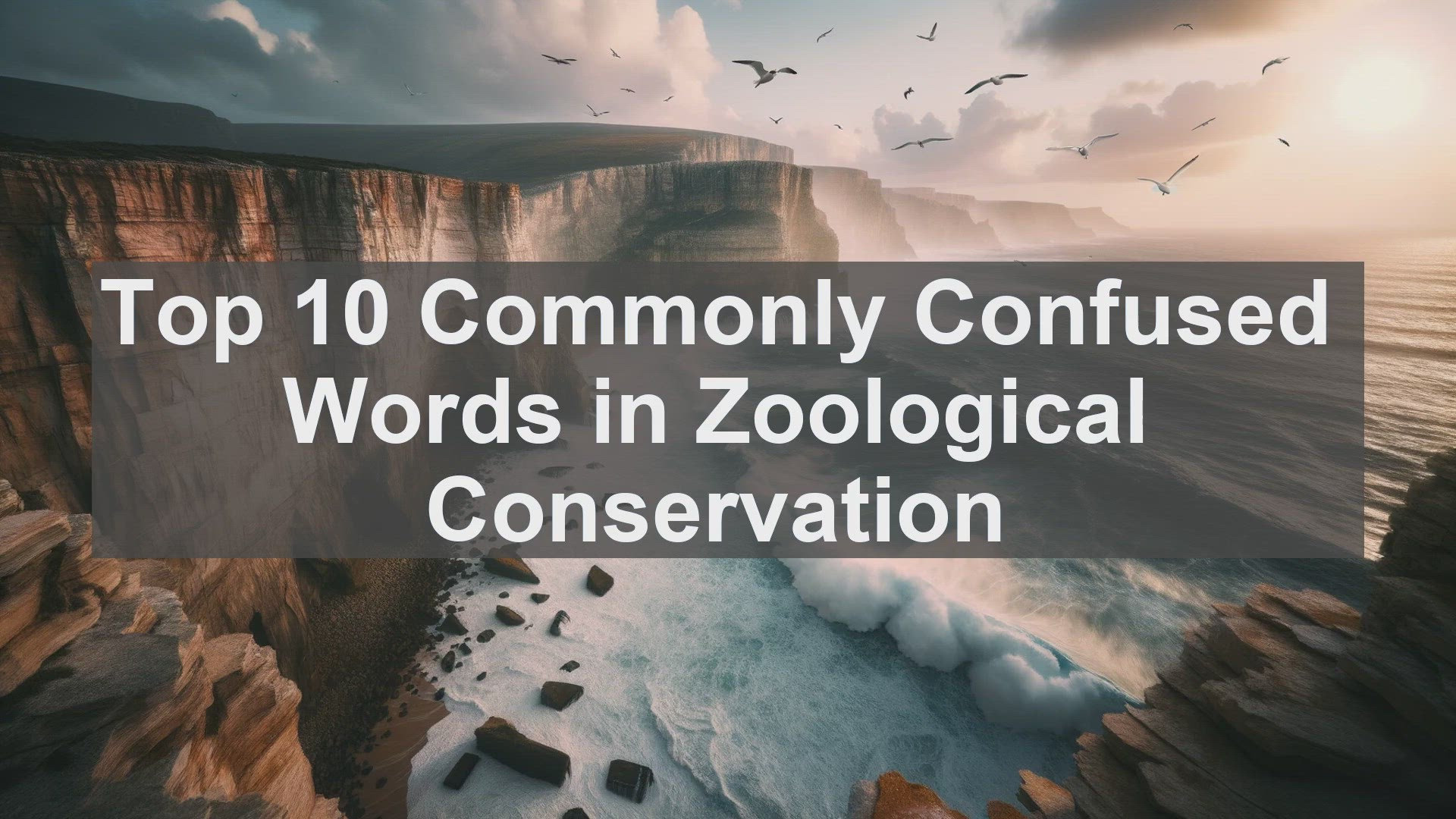
Top 10 Commonly Confused Words in Zoological Conservation
4K views · Dec 7, 2023 englishteststore.net
Top 10 Commonly Confused Words in Zoography 1. Mammal vs. Marsupial Many people mistake marsupials for mammals, but there's a crucial difference. While both groups give birth to live young, marsupials carry their underdeveloped offspring in a pouch, unlike mammals. 2. Venomous vs. Poisonous Venomous and poisonous are often used interchangeably, but they're distinct. Venom is injected, like through a snake's bite, while poison is ingested or absorbed, like the toxins on a poisonous plant's surface. 3. Herbivore vs. Omnivore Understanding an animal's diet is crucial. Herbivores solely consume plants, while omnivores have a varied diet, including both plants and other animals. 4. Habitat vs. Ecosystem Habitat refers to an organism's immediate environment, while an ecosystem encompasses the interactions between organisms and their surroundings, including the physical and biological factors. 5. Endangered vs. Extinct Endangered species are at the brink of extinction, but they still exist. Extinct species, on the other hand, no longer have any living members. 6. Prey vs. Predator In the animal kingdom, it's all about the food chain. Prey refers to the animal being hunted, while the predator is the one doing the hunting. 7. Insect vs. Arachnid Both insects and arachnids belong to the arthropod phylum, but they have distinct characteristics. Insects have six legs and three body segments, while arachnids have eight legs and two body segments. 8. Exoskeleton vs. Endoskeleton Skeletons can be internal or external. Insects, with their hard outer covering, have an exoskeleton, while humans and other vertebrates possess an endoskeleton inside their bodies. 9. Migration vs. Hibernation Animals have various strategies to cope with changing seasons. Migration involves moving to a different region, while hibernation is a state of inactivity and reduced metabolism during winter. 10. Camouflage vs. Mimicry Both camouflage and mimicry are survival strategies. Camouflage helps an animal blend into its surroundings, while mimicry involves resembling another species, often for protection. Conclusion By understanding these commonly confused words in zoography, you'll have a solid foundation for further exploration in this captivating field. Happy learning, and see you in the next lesson!

Top 10 Commonly Confused Words in Zoology and Wildlife Resea...
1K views · Dec 7, 2023 englishteststore.net
Top 10 Commonly Confused Words in Zoological Studies 1. Species vs. Breed One of the most common confusions is between 'species' and 'breed.' While 'species' refers to a group of organisms that can interbreed and produce fertile offspring, 'breed' is a term used to describe specific varieties within a species, selectively bred for certain traits. 2. Habitat vs. Ecosystem Often used interchangeably, 'habitat' and 'ecosystem' have distinct meanings. 'Habitat' refers to the specific place where an organism lives, while 'ecosystem' encompasses the entire community of organisms in a given area, along with the non-living factors they interact with. 3. Endangered vs. Extinct Understanding the difference between 'endangered' and 'extinct' is crucial for conservation efforts. 'Endangered' refers to a species that is at risk of becoming extinct, while 'extinct' means that a species no longer exists in the world. 4. Adaptation vs. Evolution While 'adaptation' refers to the process where an organism adjusts to its environment over time, 'evolution' is a broader term that encompasses the changes in a species over multiple generations, often resulting in the development of new traits. 5. Prey vs. Predator In the context of a food chain, 'prey' refers to the organism that is hunted and consumed, while 'predator' is the organism that does the hunting. It's a classic case of 'who eats whom' in an ecosystem. 6. Migration vs. Hibernation Both 'migration' and 'hibernation' are strategies used by animals to survive in challenging conditions. 'Migration' is the seasonal movement of animals from one region to another, often in search of food or better climate, while 'hibernation' is a state of prolonged inactivity to conserve energy during winter. 7. Invertebrate vs. Vertebrate The key difference between 'invertebrate' and 'vertebrate' lies in their anatomy. 'Invertebrates' are animals that lack a backbone, while 'vertebrates' have a well-developed internal skeleton made of bones or cartilage. 8. Herbivore vs. Carnivore When it comes to dietary preferences, 'herbivores' are animals that primarily consume plants, while 'carnivores' are meat-eaters. Some animals, like humans, fall into the category of 'omnivores,' as they consume both plant and animal matter. 9. Anatomy vs. Physiology While 'anatomy' focuses on the structure and organization of an organism's body parts, 'physiology' is concerned with the functions and processes that occur within those body parts. 10. Taxonomy vs. Classification Often used interchangeably, 'taxonomy' and 'classification' have slight differences. 'Taxonomy' is the science of naming, describing, and classifying organisms, while 'classification' is the process of arranging organisms into hierarchical groups based on their characteristics. Conclusion: Mastering the Vocabulary of Zoology By understanding and using these terms accurately, you'll not only enhance your communication skills in the field of zoology, but also contribute to the broader scientific community's understanding of the natural world. Keep exploring, keep learning, and happy zoological adventures ahead!

Top 10 Verbs for Describing Travel and Transportation in Eng...
1K views · Dec 7, 2023 englishteststore.net
Top 10 Verbs for Describing Travel and Transportation in English 1. 'Go' - The Ultimate Travel Verb The verb 'go' is a must-know for any traveler. It's incredibly versatile and can be used in various contexts. Whether you're going on a trip, heading to the airport, or simply exploring a new city, 'go' is your go-to verb. Remember, it's irregular in the past tense, so it becomes 'went'. 2. 'Arrive' - Reaching Your Destination After a journey, we all look forward to arriving at our destination. 'Arrive' is the verb we use to describe that moment. It signifies the completion of a trip and the beginning of new experiences. So, the next time you reach a new city or country, remember to say 'I've arrived!' 3. 'Travel' - The Act of Moving The verb 'travel' encompasses the entire experience of going from one place to another. It's a broad term that covers various modes of transportation, be it by air, land, or sea. So, whether you're taking a train, flying in a plane, or sailing on a ship, you're 'traveling'. 4. 'Explore' - Discovering New Places Traveling isn't just about reaching a destination; it's about exploring and immersing yourself in new cultures and environments. The verb 'explore' captures that sense of curiosity and adventure. From famous landmarks to hidden gems, there's always something to explore. 5. 'Navigate' - Finding Your Way In unfamiliar surroundings, knowing how to 'navigate' is essential. This verb refers to the act of finding your way, whether it's using a map, following directions, or relying on GPS. It's a skill that every traveler should have, ensuring a smooth journey. 6. 'Board' - Getting On a Vehicle When it's time to get on a plane, train, or bus, we 'board' it. This verb indicates the action of entering a vehicle, ready to embark on a new leg of your journey. So, when you hear the announcement 'Boarding now!', it's your cue to get on. 7. 'Depart' - Saying Goodbye Just as 'arrive' marks the beginning of a trip, 'depart' signifies the end. It's the verb we use when we're leaving a place, bidding farewell to the experiences we had. Departures can be bittersweet, but they also mean new adventures await. 8. 'Commute' - Daily Travel For many, travel isn't just about vacations; it's also a part of their daily routine. 'Commute' is the verb that describes this regular travel, often to work or school. Whether you take the bus, drive, or cycle, it's all a part of your daily commute. 9. 'Hitchhike' - Adventurous Travel For the more adventurous souls, 'hitchhiking' is an option. This verb refers to the act of getting a free ride from passing vehicles. While it's not as common nowadays, it still holds a certain allure for those seeking unique travel experiences. 10. 'Return' - Coming Back After a trip, there's always the journey back home. 'Return' is the verb we use to describe that action. It signifies the end of your travel and the start of settling back into your familiar surroundings. 'Return' can also be used in the context of round trips. Conclusion: Verbs that Bring Travel to Life And there you have it, the top 10 verbs for describing travel and transportation. By incorporating these verbs into your vocabulary, you'll be able to paint a vivid picture of your travel experiences. So, whether you're planning a trip or simply dreaming of one, remember the power of verbs. Happy travels!
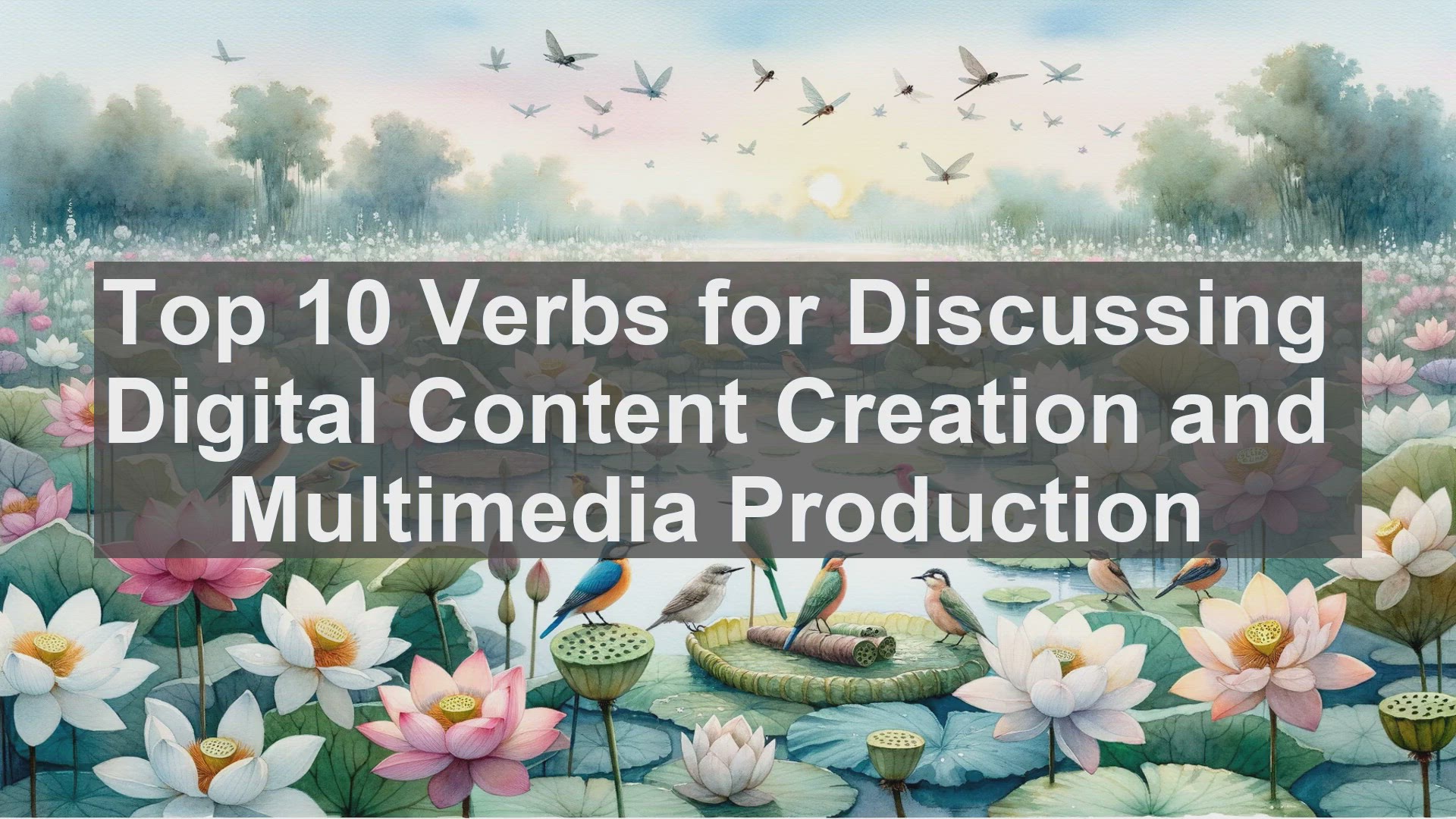
Top 10 Verbs for Discussing Digital Content Creation and Mul...
13K views · Dec 7, 2023 englishteststore.net
Top 10 Verbs for Discussing Digital Content Creation and Multimedia Production 1. Create The first verb on our list is 'create'. It's the foundation of digital content production. Whether it's a video, an image, or a piece of written content, everything starts with creation. It's the process of bringing an idea to life using various tools and techniques. 2. Edit Next up, we have 'edit'. Once the initial content is created, it often requires refinement. That's where editing comes in. It involves making changes, adding or removing elements, and ensuring the final product is polished and coherent. 3. Design Designing is a crucial aspect of multimedia production. It's not just about aesthetics but also about functionality. Whether it's a website, an app, or a graphic, design plays a significant role in user experience and engagement. 4. Produce After the creation and editing stages, it's time for production. This involves the actual execution of the project, be it rendering a video, printing a document, or publishing an article. It's the step where the content becomes ready for distribution. 5. Collaborate In today's digital landscape, collaboration is key. Many projects require a team effort, with individuals bringing their expertise together. Collaborating involves effective communication, task delegation, and ensuring everyone is on the same page. 6. Optimize Once the content is created and published, the work doesn't end there. Optimization is crucial for maximizing its reach and impact. It can involve anything from SEO techniques for a blog post to compression methods for a video. 7. Analyze In the digital realm, data is abundant. Analyzing this data is essential for understanding the performance of your content. It can involve metrics like views, engagement, or even user feedback. This analysis helps in making informed decisions for future projects. 8. Promote Promotion is a vital step in content creation. After all, what good is great content if it doesn't reach the intended audience? Promoting involves various strategies, from social media marketing to email campaigns, with the goal of increasing visibility and engagement. 9. Engage Engagement is more than just views or likes. It's about creating a connection with your audience. This can be through interactive elements in a video, a comment section on a blog, or even live Q&A sessions. Engaging content keeps the audience coming back for more. 10. Evolve The digital landscape is ever-changing. What works today may not work tomorrow. That's why it's crucial to constantly evolve and adapt. This can involve staying updated with the latest trends, learning new tools, or even experimenting with different content formats. Conclusion And there you have it, the top 10 verbs for discussing digital content creation and multimedia production. By incorporating these verbs into your vocabulary, you'll not only enhance your understanding but also be able to communicate your ideas and strategies effectively. So, keep learning, keep creating, and embrace the exciting world of digital content. Thank you for watching, and I'll see you in the next video!
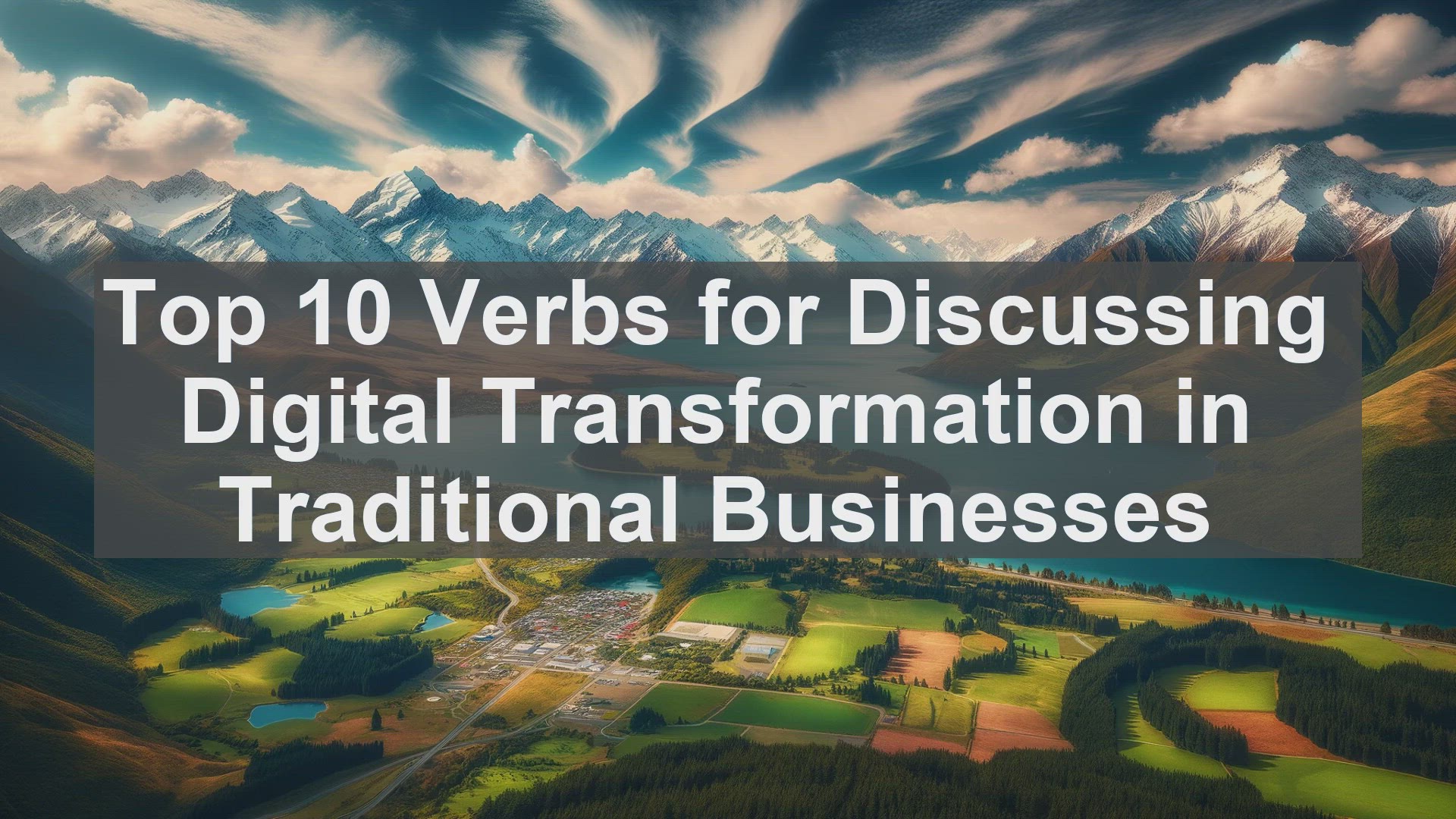
Top 10 Verbs for Discussing Digital Transformation in Tradit...
302 views · Dec 7, 2023 englishteststore.net
Top 10 Verbs for Discussing Digital Transformation in Traditional Businesses 1. Adopt The first verb on our list is 'adopt.' It refers to the process of integrating new digital technologies or strategies into the existing business model. For example, a traditional retail store might adopt an e-commerce platform to reach a wider customer base. 2. Implement Next, we have 'implement.' This verb signifies the actual execution of a digital transformation plan. It involves putting the strategies into action, be it setting up new software or training employees on using digital tools effectively. 3. Integrate When we talk about 'integrate,' we're referring to the seamless merging of digital and traditional processes. It's not just about having separate digital initiatives but ensuring they work in harmony with the existing operations. 4. Automate Automation is a key aspect of digital transformation. By 'automating' certain tasks or processes, businesses can not only save time but also reduce the chances of human error. For instance, an automated inventory management system can streamline stock control. 5. Analyze With the vast amount of data available today, 'analyzing' it becomes crucial. By using advanced analytics tools, businesses can gain valuable insights into customer behavior, market trends, and more. This, in turn, helps in making informed decisions. 6. Enhance Digital transformation isn't just about replacing traditional methods; it's about 'enhancing' them. For example, a traditional marketing campaign can be enhanced by incorporating social media strategies or influencer collaborations. 7. Optimize When we 'optimize' a process or system, we're essentially making it more efficient or effective. In the context of digital transformation, this could mean streamlining workflows, improving website loading speed, or enhancing the user experience. 8. Scale Scalability is a crucial factor in today's digital landscape. When a business is said to 'scale,' it means it can handle growth or increased demand without compromising on quality or performance. Digital tools often enable this scalability. 9. Collaborate Collaboration is essential in any digital transformation journey. By 'collaborating' with different stakeholders, be it internal teams or external partners, businesses can ensure a holistic and well-rounded approach to the transformation process. 10. Evolve Our final verb is 'evolve.' Digital transformation is not a one-time process; it's an ongoing journey. Businesses need to constantly adapt, learn, and evolve to stay ahead in the digital age. This verb embodies that continuous growth mindset. Conclusion: The Power of Verbs in Digital Transformation So there you have it - the top 10 verbs for discussing digital transformation in traditional businesses. By understanding and applying these verbs, businesses can navigate the digital landscape more effectively. Remember, it's not just about the technology; it's about the actions we take. Thank you for watching, and see you in the next video!

Top 10 Verbs for Discussing Literary Analysis and Criticism
21K views · Dec 8, 2023 englishteststore.net
Top 10 Verbs for Discussing Literary Analysis and Criticism 1. Depict: Painting Vivid Pictures with Words To 'depict' is to vividly describe or portray something. In literary analysis, this verb is often used to discuss how an author paints a scene, character, or emotion with words. For example, 'The author adeptly depicts the gloomy atmosphere of the haunted house, creating a sense of foreboding.' 2. Convey: Communicating Ideas and Themes When we say a text 'conveys' something, we mean it effectively communicates an idea, theme, or message. This verb is frequently employed to analyze how an author expresses complex concepts. For instance, 'Through the protagonist's internal monologue, the author skillfully conveys the protagonist's inner turmoil.' 3. Evoke: Stirring Emotions and Memories To 'evoke' is to bring forth or elicit a particular feeling, emotion, or memory. In literary analysis, this verb is often used to discuss how a text triggers a reader's response. For example, 'The author's vivid descriptions of nature evoke a sense of tranquility and nostalgia.' 4. Subvert: Challenging Conventional Expectations When a text 'subverts' something, it defies or challenges established norms, expectations, or conventions. This verb is frequently used in critical analysis to highlight an author's unconventional approach. For instance, 'The author's use of dark humor subverts the traditional portrayal of tragedy.' 5. Foreshadow: Hinting at Future Events To 'foreshadow' is to give a hint or suggestion of something that will happen later in the text. This verb is often employed to analyze an author's use of subtle clues. For example, 'The mention of the raven in the opening scene foreshadows the protagonist's impending doom.' 6. Symbolize: Objects as Carriers of Meaning When an object or element 'symbolizes' something, it represents or stands for a deeper, often abstract, concept. This verb is frequently used to explore the layers of meaning in a text. For instance, 'The white whale in the novel symbolizes both vengeance and the destructive power of obsession.' 7. Juxtapose: Contrasting Elements for Effect To 'juxtapose' is to place two or more contrasting elements side by side for comparison or contrast. This verb is often employed to analyze an author's deliberate choices. For example, 'The author's decision to juxtapose the opulence of the palace with the poverty of the surrounding village highlights the stark social divide.' 8. Illuminate: Shedding Light on Complexities When we say a text 'illuminates' something, we mean it provides clarity or insight into a complex idea or situation. This verb is frequently used to discuss how an author brings forth understanding. For instance, 'The author's use of anecdotes effectively illuminates the challenges faced by immigrants.' 9. Satirize: Using Humor to Critique To 'satirize' is to use humor, irony, or exaggeration to criticize or mock something. This verb is often employed in the analysis of satirical works. For example, 'The author satirizes the political establishment through the absurd actions of the protagonist.' 10. Underscore: Emphasizing Significance When we say something 'underscores' a point, we mean it highlights or emphasizes its importance. This verb is frequently used to discuss an author's deliberate choices. For instance, 'The author's use of repetition underscores the recurring theme of isolation.' Conclusion: Verbs as the Building Blocks of Analysis By incorporating these 10 verbs into your literary analysis and criticism, you'll be able to delve deeper into the nuances of a text. Remember, verbs are the building blocks that allow us to dissect, interpret, and appreciate the complexities of literature. Happy analyzing!

Top 10 Verbs for Talking About Cryptocurrency Trading and Bl...
337 views · Dec 8, 2023 englishteststore.net
Top 10 Verbs for Talking About Community-Led Development and Local Initiatives 1. Engage Engagement is at the heart of community-led development. It involves actively involving community members in decision-making processes, ensuring their voices are heard, and their perspectives are considered. When you engage with a community, you're not just informing them; you're creating a space for collaboration and co-creation. 2. Empower Empowerment is about giving individuals or groups the tools, resources, and knowledge they need to take charge of their own development. It's not about doing things for them but rather equipping them with the skills and confidence to do it themselves. When you empower a community, you're fostering sustainability and long-term impact. 3. Mobilize Mobilization is all about bringing people together for a common cause. It could be for a community project, a campaign, or a collective action. When you mobilize, you're not just gathering individuals; you're creating a sense of unity, shared purpose, and collective strength. 4. Assess Assessment is a crucial step in any community-led initiative. It involves gathering data, analyzing needs, strengths, and challenges, and using that information to inform decision-making. When you assess, you're not just relying on assumptions; you're basing your actions on evidence and insights. 5. Collaborate Collaboration is the essence of community work. It's about working together, pooling resources, and sharing responsibilities. When you collaborate, you're not just adding your individual efforts; you're creating a synergy that leads to more impactful outcomes. 6. Advocate Advocacy is about speaking up for a cause or an issue. It involves raising awareness, influencing policies, and mobilizing support. When you advocate, you're not just expressing your opinion; you're being a voice for those who might not have the platform to be heard. 7. Implement Implementation is the action phase of any community-led initiative. It's about putting plans into practice, overseeing activities, and ensuring progress. When you implement, you're not just talking about ideas; you're making them a reality. 8. Evaluate Evaluation is a continuous process in community work. It involves assessing the impact, effectiveness, and sustainability of an initiative. When you evaluate, you're not just looking at the end result; you're learning from the process and using that knowledge to improve future actions. 9. Network Networking is about building connections and relationships within and beyond the community. It's not just about who you know but also about fostering meaningful collaborations and partnerships. When you network, you're expanding the reach and resources available for community work. 10. Sustain Sustainability is a key principle in community-led development. It's about ensuring that the impact of an initiative lasts beyond its initial phase. When you sustain, you're not just focusing on short-term gains; you're thinking about the long-term well-being and resilience of the community. Conclusion And there you have it! The top 10 verbs for talking about community-led development and local initiatives. By incorporating these verbs into your vocabulary, you'll be better equipped to engage, empower, and make a positive difference in any community. Remember, community work is not just about the actions we take; it's about the relationships we build and the impact we create. Thank you for watching, and see you in the next video!

Top 10 English Slangs for Home Economist
1K views · Dec 16, 2023 englishteststore.net
Top 10 English Slangs for Home Economist 1. Budget Buster A 'budget buster' refers to something that is likely to exceed the allocated budget. In home economics, it could be a costly ingredient or a kitchen appliance. By being aware of this slang, you can plan your expenses more effectively. 2. Foodie You might have heard this term before. A 'foodie' is someone who has a deep passion for food. In the world of home economics, being a foodie is a great advantage. It means you're genuinely interested in exploring new recipes, ingredients, and culinary techniques. 3. Pantry Raid A 'pantry raid' is when you go through your pantry or kitchen cabinets to find ingredients for a meal. It's a creative way of cooking, where you make the most of what you already have. As a home economist, you'll often need to do pantry raids to come up with delicious and economical meals. 4. Farm-to-Table The 'farm-to-table' movement emphasizes using locally sourced, fresh ingredients in cooking. It promotes sustainability and supports local farmers. As a home economist, you'll appreciate the importance of farm-to-table practices in creating healthy and environmentally friendly meals. 5. Freegan A 'freegan' is someone who chooses to consume discarded or wasted food. It's a way of reducing food waste and being mindful of our resources. While not everyone may embrace this lifestyle, understanding the concept of freeganism can make you more conscious about minimizing food waste. 6. Meal Prep Meal prepping involves preparing meals in advance, usually for the week. It's a time-saving strategy and ensures you have nutritious meals ready to go. Home economists often recommend meal prepping to individuals who have busy schedules but still want to eat healthily. 7. Food Miles When we talk about 'food miles,' we're referring to the distance food travels from its source to the consumer. The concept of food miles ties into sustainability and carbon footprint. By choosing locally sourced ingredients, you can reduce the food miles and contribute to a greener planet. 8. Slow Food In contrast to fast food, 'slow food' is all about taking the time to prepare and savor a meal. It's about enjoying the process of cooking and appreciating the flavors. As a home economist, you'll often advocate for slow food practices, as they promote healthier eating habits. 9. One-Pot Wonder A 'one-pot wonder' is a dish that can be cooked using just one pot or pan. It's a convenient and time-saving cooking method. Home economists often share one-pot wonder recipes, as they're not only easy to prepare but also require minimal cleanup. 10. Food Desert A 'food desert' is an area where access to fresh, affordable, and nutritious food is limited. It's a significant issue in many communities. As a home economist, you may work towards finding solutions to food deserts, such as promoting community gardens or farmers' markets. Conclusion And there you have it, the top 10 English slangs for home economists. By familiarizing yourself with these slangs, you'll not only enhance your language skills but also gain a deeper understanding of the field. So, keep exploring, keep learning, and soon, you'll be a pro in the world of home economics. Thank you for watching!

Top 10 English Slangs for Mining Engineer
2 views · Dec 17, 2023 englishteststore.net
Top 10 English Slangs for Mining Engineer 1. 'Mother Lode' The term 'Mother Lode' refers to a rich and abundant source of valuable minerals or ore. It's often used to describe a particularly profitable mining site. For example, if someone says, 'We hit the mother lode!', it means they've discovered a highly valuable deposit. So, keep an ear out for this slang when discussing potential mining locations. 2. 'Black Lung' While mining is a rewarding profession, it does come with its risks. 'Black Lung' is a term used to describe a respiratory condition caused by prolonged exposure to coal dust. It's a serious concern in the industry, and measures are taken to prevent it. So, if you hear someone mentioning 'black lung', it's a reminder of the importance of safety measures. 3. 'Highwall' In surface mining, the 'highwall' refers to the exposed vertical face of a quarry or open-pit mine. It's often a towering structure and requires careful engineering to ensure stability. When discussing mining operations, you might hear phrases like 'working the highwall' or 'highwall mining', indicating activities related to this specific area. 4. 'Muck' The term 'muck' is used to describe the broken or fragmented rock and soil that's excavated during mining. It's a common sight in mining operations, and efficient muck handling is crucial for smooth workflow. So, if you hear someone talking about 'muck', they're referring to the material being moved or processed. 5. 'Jumbo Drill' A 'jumbo drill' is a large, powerful drilling machine used in underground mining. It's capable of drilling holes for various purposes, such as blasting or exploration. The term 'jumbo' comes from the machine's size and capabilities. If you're working in underground mining, you'll often come across this term in discussions about drilling operations. 6. 'Tailings' After the valuable minerals have been extracted from the ore, what remains is known as 'tailings'. These are the byproducts of the mining process and are often stored in tailings ponds or dams. Managing tailings is an important aspect of mining operations, as they need to be stored and handled properly to minimize environmental impact. 7. 'Gob' In underground coal mining, 'gob' refers to the waste material, primarily consisting of coal and rock, left behind after extraction. Proper management of gob is crucial for safety and environmental reasons. If you're involved in coal mining, you'll frequently encounter this term in discussions about waste disposal or reclamation. 8. 'Assay' When it comes to determining the quality and composition of minerals, 'assay' is the term to know. It refers to the analysis and testing of samples to determine their mineral content. Accurate assays are essential for assessing the economic viability of a mining project. So, if you're working in the field of mineral exploration, 'assay' is a term you'll come across often. 9. 'Cage' In underground mining, a 'cage' is a device used to transport miners and equipment up and down the mine shaft. It's essentially an elevator designed for the mining environment. When someone mentions 'cage', they're referring to this vital piece of equipment that ensures safe vertical movement in the mine. 10. 'Glory Hole' Now, before your imagination runs wild, let me clarify. In mining, a 'glory hole' is a term used to describe a vertical or near-vertical hole that's used for exploration or ore extraction. It's often a deep hole, and the term 'glory' refers to the potential riches it may hold. So, if you hear someone talking about a 'glory hole', they're not referring to something scandalous, but rather an important mining feature. Conclusion And that brings us to the end of our list. These are just a few of the many English slangs used in the mining industry. Mastering these slangs will not only help you communicate effectively but also make you feel like a part of the mining community. So, keep learning, keep exploring, and who knows, maybe one day, you'll be coining your own mining slangs. Thank you for watching, and we'll see you in the next video!
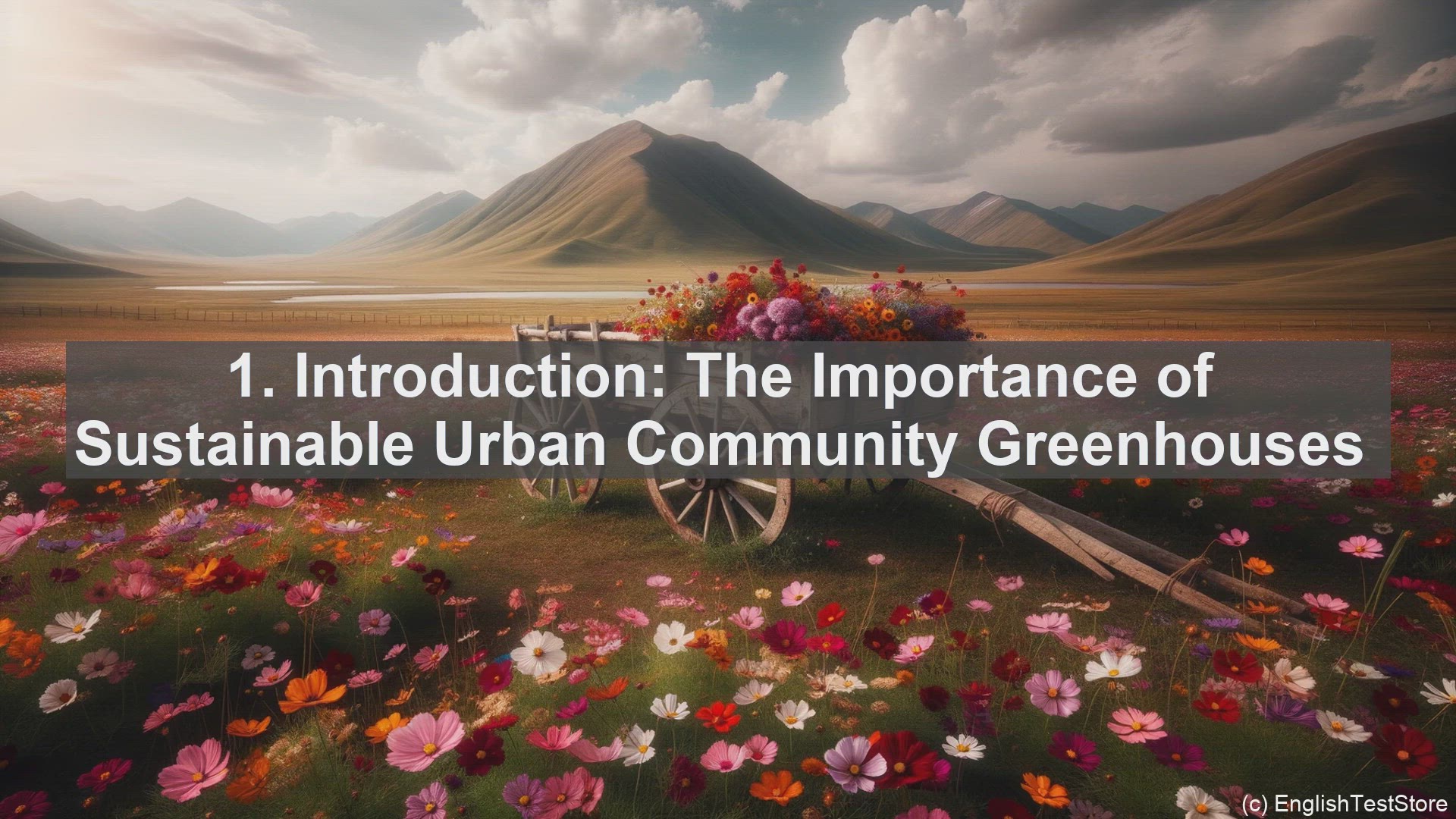
Top 10 Phrases for Talking about Sustainable Urban Community...
41 views · Jan 13, 2024 englishteststore.net
Top 10 Phrases for Talking about Sustainable Urban Community Greenhouses 1. Introduction: The Importance of Sustainable Urban Community Greenhouses Hello, students! Today, we delve into the world of sustainable urban community greenhouses. These innovative structures play a crucial role in addressing food security, promoting environmental stewardship, and fostering community engagement. 2. Food Security: Ensuring Access to Fresh Produce One of the primary benefits of urban community greenhouses is their contribution to food security. By cultivating crops in close proximity to urban areas, we reduce the reliance on long-distance transportation, ensuring that fresh, nutritious produce is readily available to all. 3. Climate Resilience: Mitigating the Impact of Extreme Weather In an era of climate change, extreme weather events are becoming more frequent. Urban community greenhouses, with their controlled environments, offer a haven for plants, shielding them from the vagaries of nature and ensuring a stable supply of food. 4. Biodiversity: Creating Miniature Ecosystems Greenhouses are not just about growing crops; they are also about fostering biodiversity. By carefully selecting companion plants and creating suitable habitats, we can mimic natural ecosystems, promoting the presence of beneficial insects and reducing the need for pesticides. 5. Education: A Classroom Under Glass Urban community greenhouses are not just production facilities; they are also invaluable educational resources. Students can witness the entire life cycle of plants, learn about sustainable growing practices, and develop a deeper appreciation for nature's intricacies. 6. Community Engagement: Gardens that Unite Greenhouses often serve as community hubs, bringing people together. Whether it's through volunteer programs, workshops, or farmers' markets, these spaces foster a sense of belonging and encourage active participation in local food systems. 7. Vertical Farming: Maximizing Space Efficiency With urban areas becoming denser, space is at a premium. Vertical farming, a technique commonly used in urban community greenhouses, allows for the cultivation of crops in multiple layers, significantly increasing the yield per square foot. 8. Water Conservation: Smart Irrigation Strategies Water, a precious resource, is used judiciously in sustainable urban community greenhouses. Techniques such as drip irrigation and water recycling minimize wastage, ensuring that every drop counts. 9. Energy Efficiency: Harnessing the Power of the Sun Greenhouses are designed to make the most of natural light, reducing the need for artificial lighting during the day. Additionally, solar panels can be installed to generate clean, renewable energy for other greenhouse operations. 10. Conclusion: A Bright Future for Sustainable Urban Community Greenhouses As we look ahead, the role of urban community greenhouses in creating resilient, sustainable cities becomes increasingly vital. By embracing these innovative spaces, we can build communities that are not just greener but also more connected and inclusive.

How to Use Overridden In Sentences - Examples Of Overridden ...
46 views · May 12, 2024 englishteststore.net
Search your words in sentences https://englishteststore.net/index.php?option=com_content&view=article&id=20211&Itemid=1131 - If there is another type beyond these that is needed, this parameter can be overridden manually. - These error outputs can be overridden by using. - Verifiability is a Wikipedia policy that cannot be overridden by a consensus of editors on a particular article. - Regardless, with training, eye dominance can be overridden. - The overridden method may be intentionally incomplete, and reliant on the overriding method to augment its functionality in a prescribed manner. - This was the first veto to be successfully overridden by Congress. - The former can generally be overridden by express agreement between the partners. - The Hood family is overridden with lies. - Before Mount Price was overridden by glacial ice, volcanic activity took place on its northern flank where a satellite vent is present. - These defaults may be overridden by the programmer. - This resulted in a consensus to delete that was considered to be overridden by the number requests that it go to RfC. - The legislature has overridden several of his vetoes of legislation. - Reagan vetoed the act, but the veto was overridden by Congress. - With regard to most issues, the Federal Council only possesses a dilatory right of veto which can be overridden by the National Council. - Such vetoes cannot be overridden. - A method that will be overridden must be indicated as virtual. - This is done by including a section in the law clearly specifying which rights have been overridden. - Yet when I made corrections they were simply overridden. - Manual control of ride height was retained, though it was overridden by the computer if the car was driven at an inappropriate speed for the selected height. - Methods that are declared private or static cannot be overridden either because they are implicitly final. - Deletions can be overridden by the legislature. - With the ability to undelete images, admin actions can now be overridden by another admin. - Zenovich said, a strong public reaction against his misdeeds in the original case seem to have overridden concerns about any misdeeds in the courts. - This template currently only supports an overridden mock headers 2 and 3, not level 4, 5, or 6. - The electoral college has overridden the popular vote at least five times, the most recent in the 2000 election. - But as mentioned before, the default is overridden for some projects, like enwiki. - This value may be overridden if a particular column specifies a desired number of rows to span. - Rules can be overridden immediately by a parent. - You then complain when the default colours are overridden? - The mayor may veto ordinances, but that can be overridden by at least two thirds of the council. - The counter argument is that centrifugal force as observed on an object at rest in the inertial frame is overridden by a radially inward Coriolis force. - Would this be overridden by the higher pressure found inside the can? - An admin ruling that the award is notable should not be overridden based solely on the vague allusion to a past discussion by a single editor. - when does good faith get overridden. - Sorry folks, but F7b is mandatory and cannot be overridden by keep votes here. - Tyler was the first president to see his veto of legislation overridden by Congress. - As with the comments above, there has yet to be an argument advanced as to why the defaults need overridden at all, let alone in completely arbitrary ways. - In this way, all windows can behave the same way when dragged, etc., unless specifically overridden by the user. - In this case, the President could not order the impoundment of substantial amounts of environmental protection funds for a program he had vetoed, and which Congress had overridden. - Then this behaviour can be overridden with template parameters for exceptional cases. - Johns and leave the farm to be overridden by walkers. - You should not have overridden me but you shoul dhave informed me of me error and given me a chance to mark it as withdrawn. - Fundamental rights cannot be overridden by general or ambiguous words. - The option needs to prevent its download until overridden and not just hide it from view, or the speed saving would be lost. - Thus, in a simple equation, it is possible that their preferences will be overridden by that of a parent. - The Lord would not have us to do something that was done in the Old Testament days, if it has been overridden with something more appropriate in the New Testament. - The town is overridden by corruption, prostitution and organized crime.